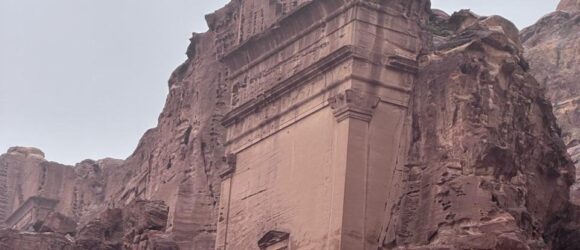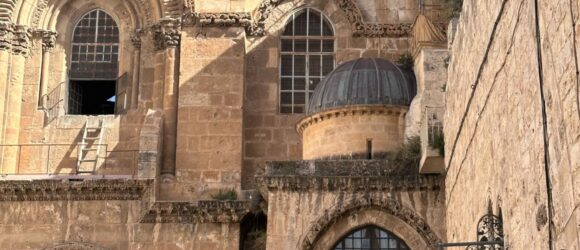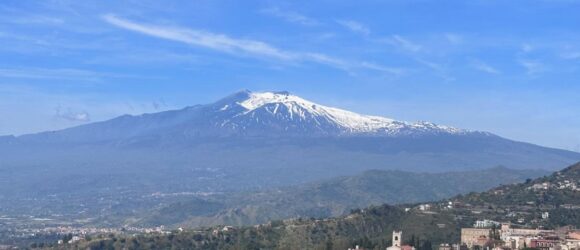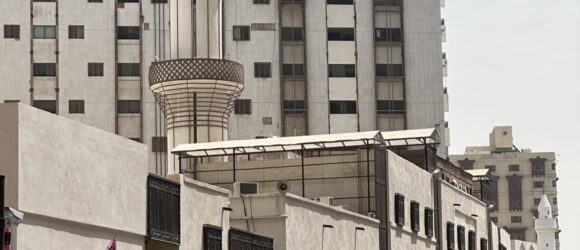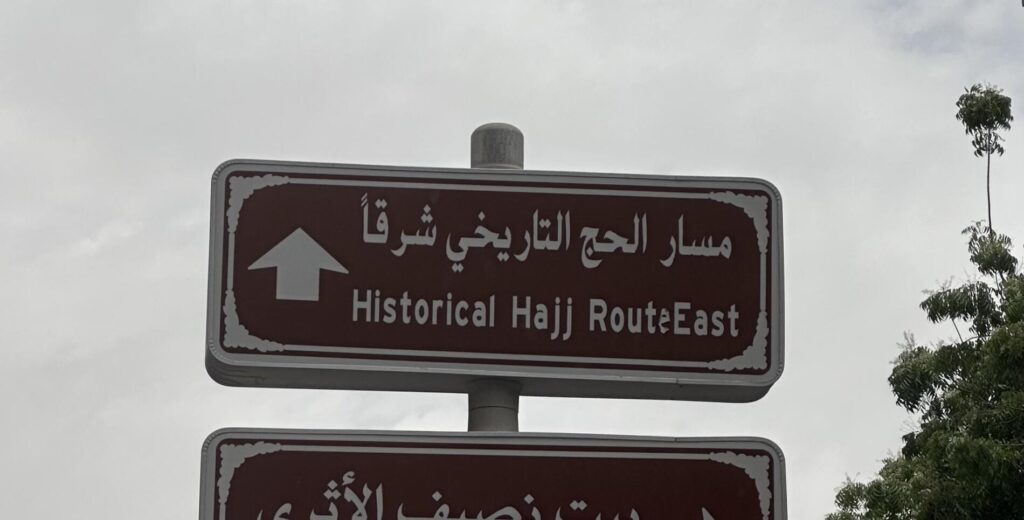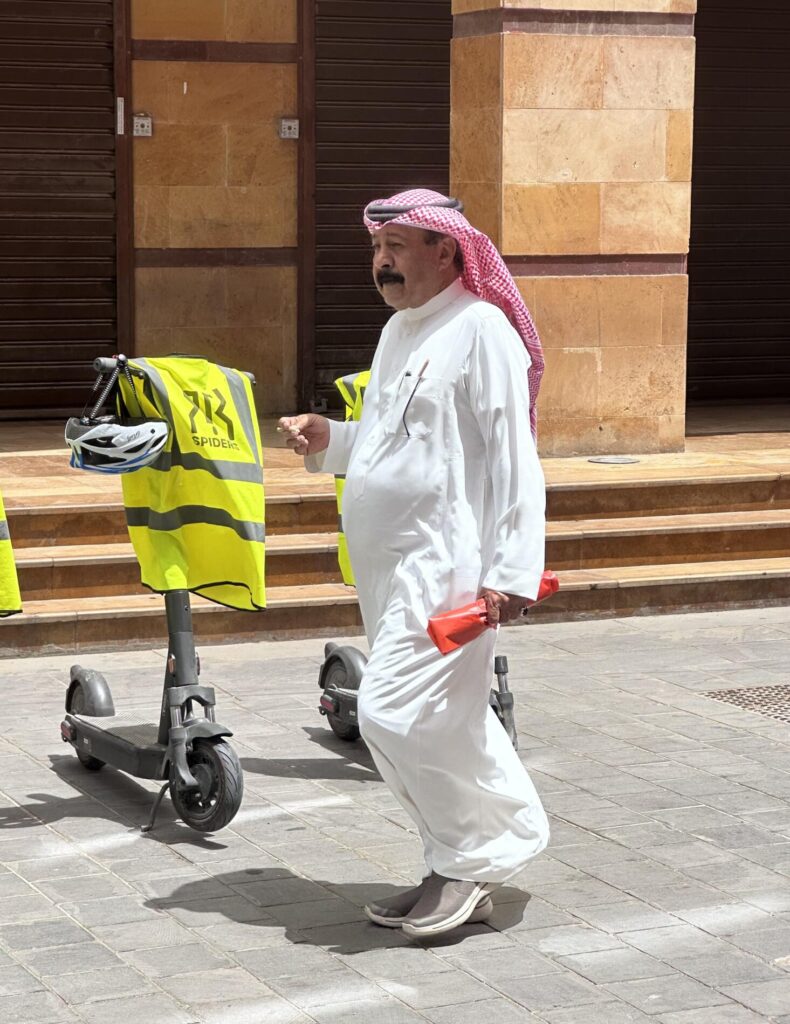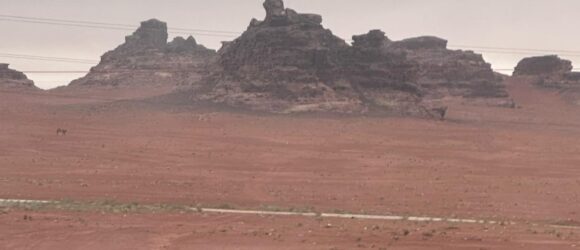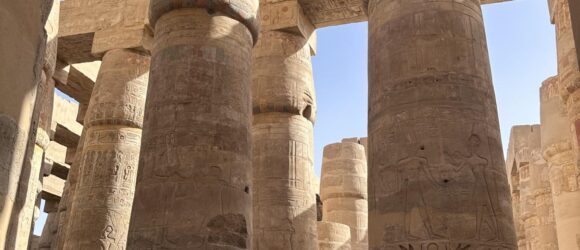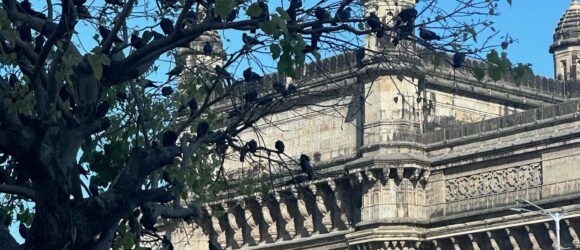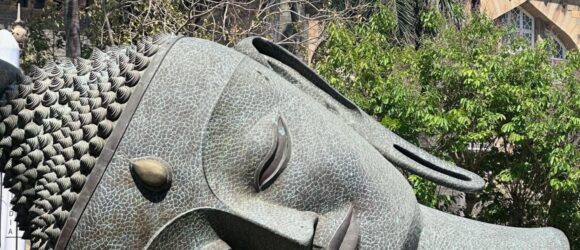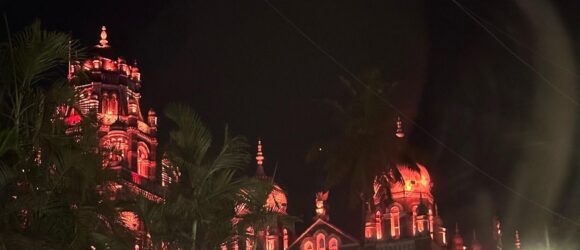Jordan, Part 3 – Petra Continued
- At October 22, 2023
- By Jessica
- In Travel
 0
0
The Roman Theater seats 4,000
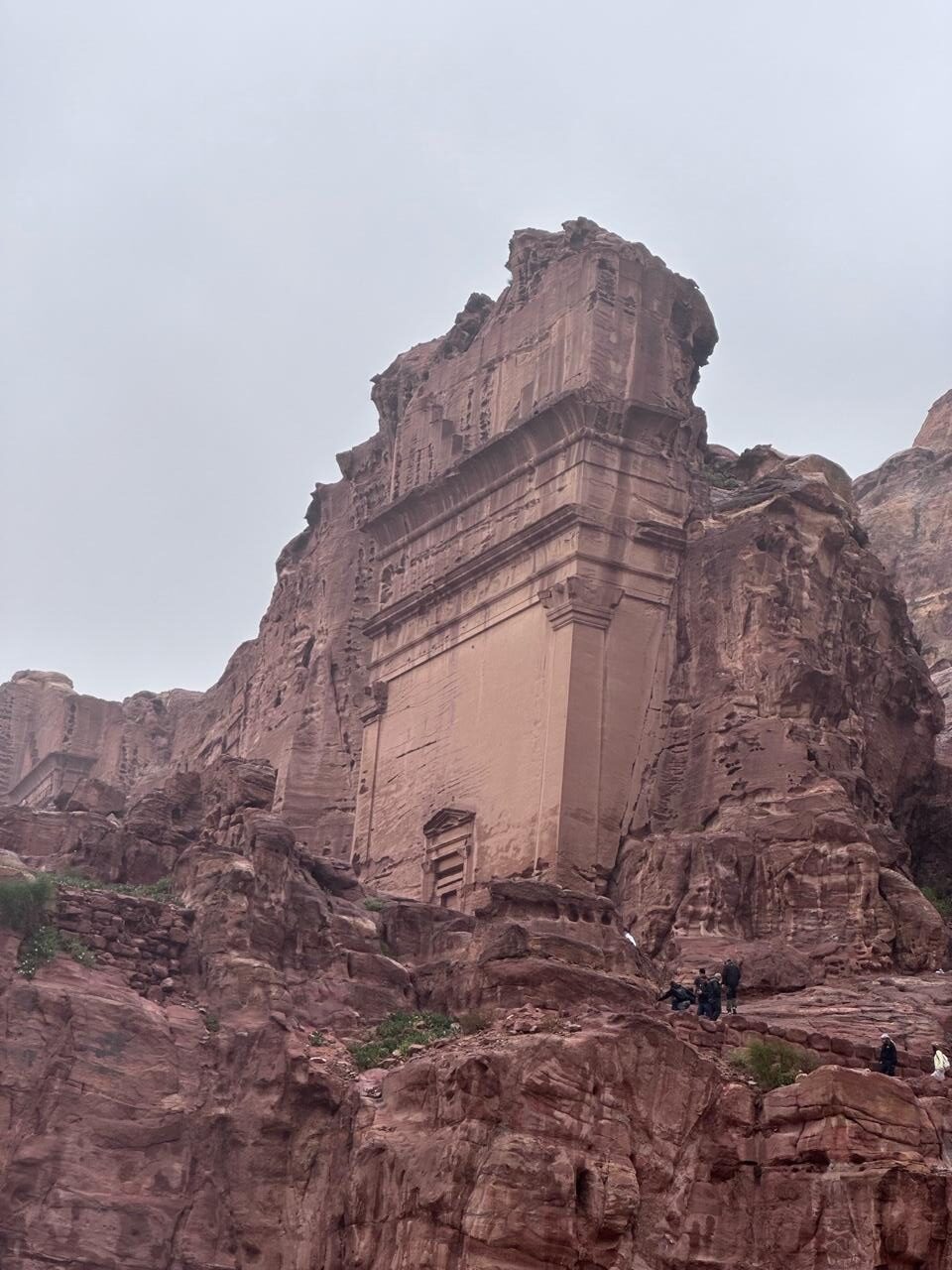
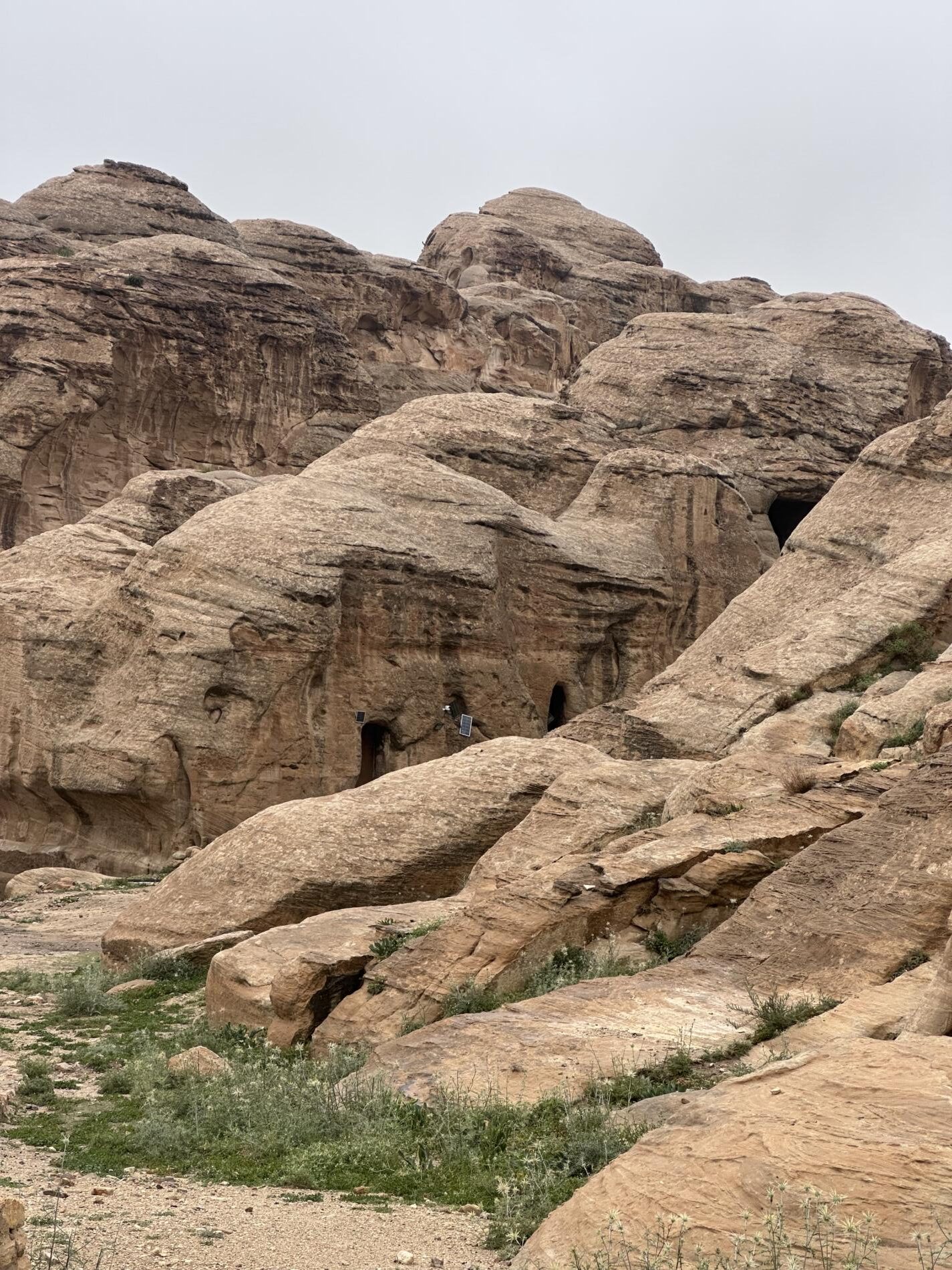
We also saw The Colonnaded Street from Roman times, the Great Temple, The Lion Triclinium with a head of Medusa at each end. The Monastery dates to the early second century but was converted to a church by the Christians during the Crusades, hence the name.
We doubt anyone wants a Part 4 but there is much, much more. Petra is a place not to miss!!
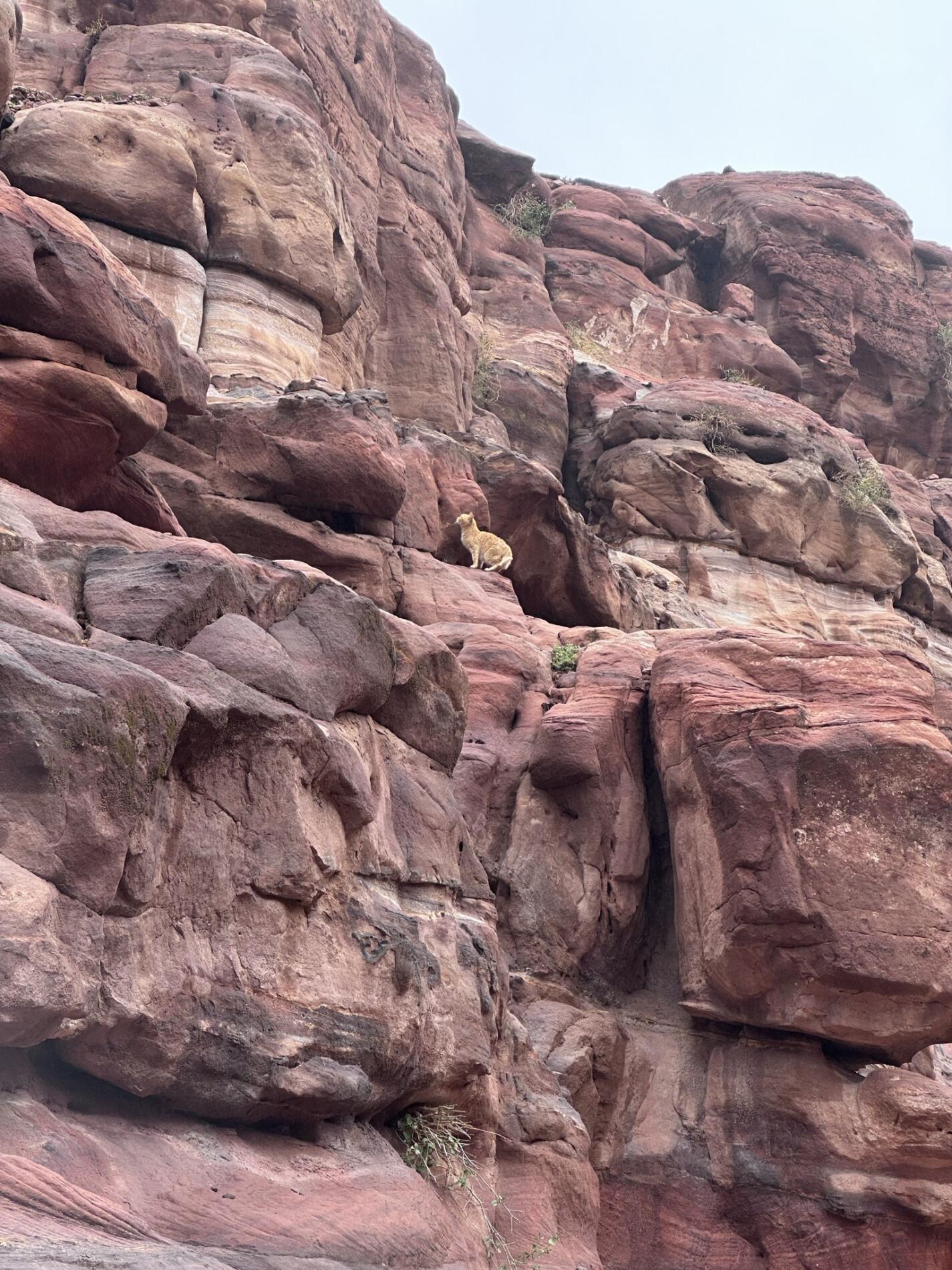
Israel, Day 2 Jerusalem
- At October 15, 2023
- By Jessica
- In Travel
 0
0
Some Fun Facts about Israel:
- The cherry tomato was developed by the Agriculture Faculty of The Hebrew University
- Israeli banknotes have braille markings on them
- Hebrew is the only dead language ever to be revived and spoken by an entire nation
- Neither Jews nor Arabs allow cremation. There are lots of cemeteries in Israel, including The 600 year old Mount of Olives in Jerusalem. It is the oldest, continually used cemetery in the world. It is close to but outside of the Old City. It is said that when the Messiah comes those buried in Mount of Olives will be the first to be resurrected and the first to enter the third temple.
The Old City is not a ruin but a vibrant place with lots of people still living there. Jews are not allowed to live amongst the dead, which is why the cemeteries are outside the cities.
The walls of the Old City were built by the Ottoman Turks 500 years ago. We like this picture showing the wall, the Israeli flag, and an Ottoman minaret. Note the crescent moon on top.
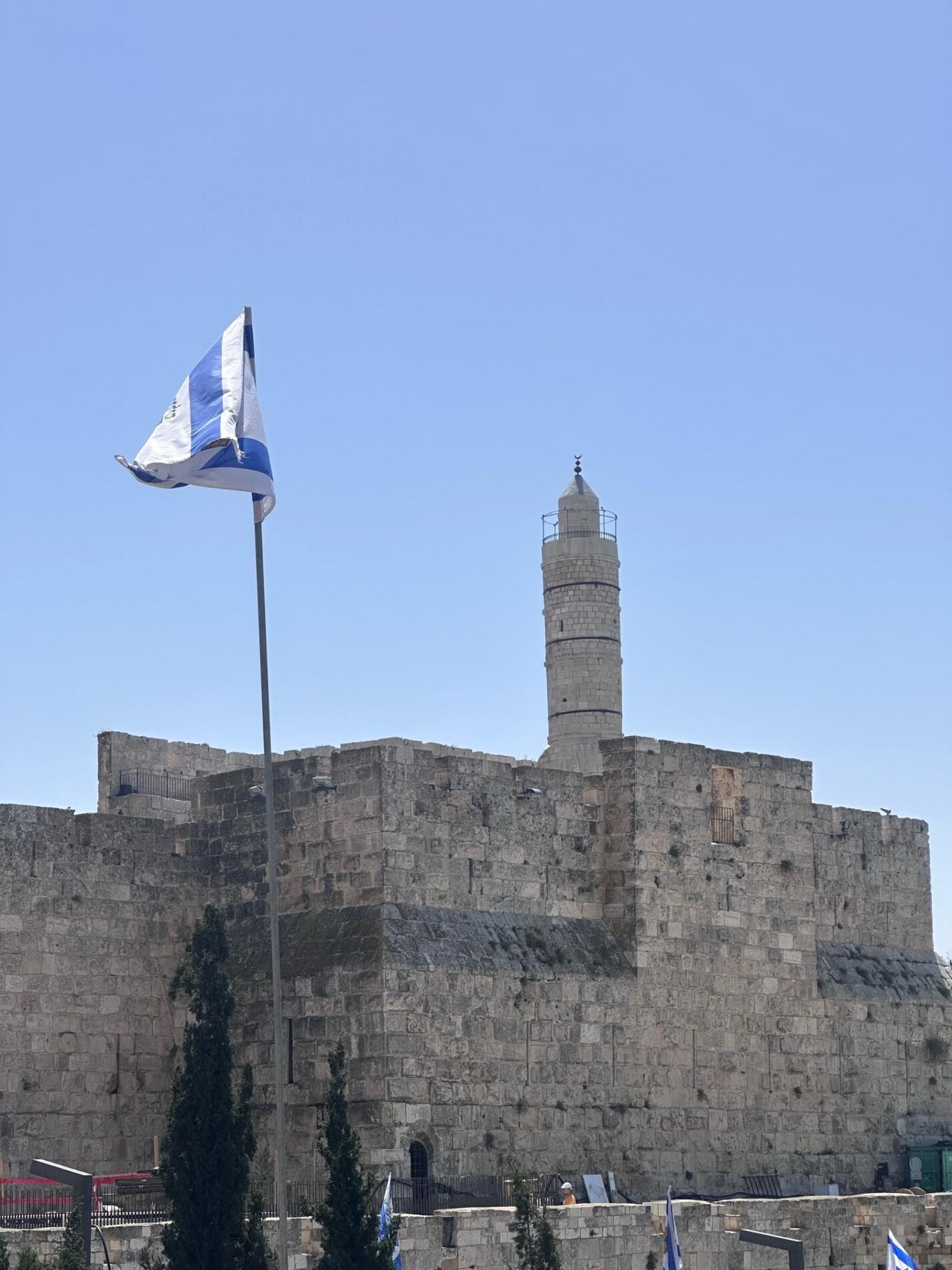
After breakfast, which included more halva, our first stop was the Church of the Holy Sepulcher in the Christian Quarter.
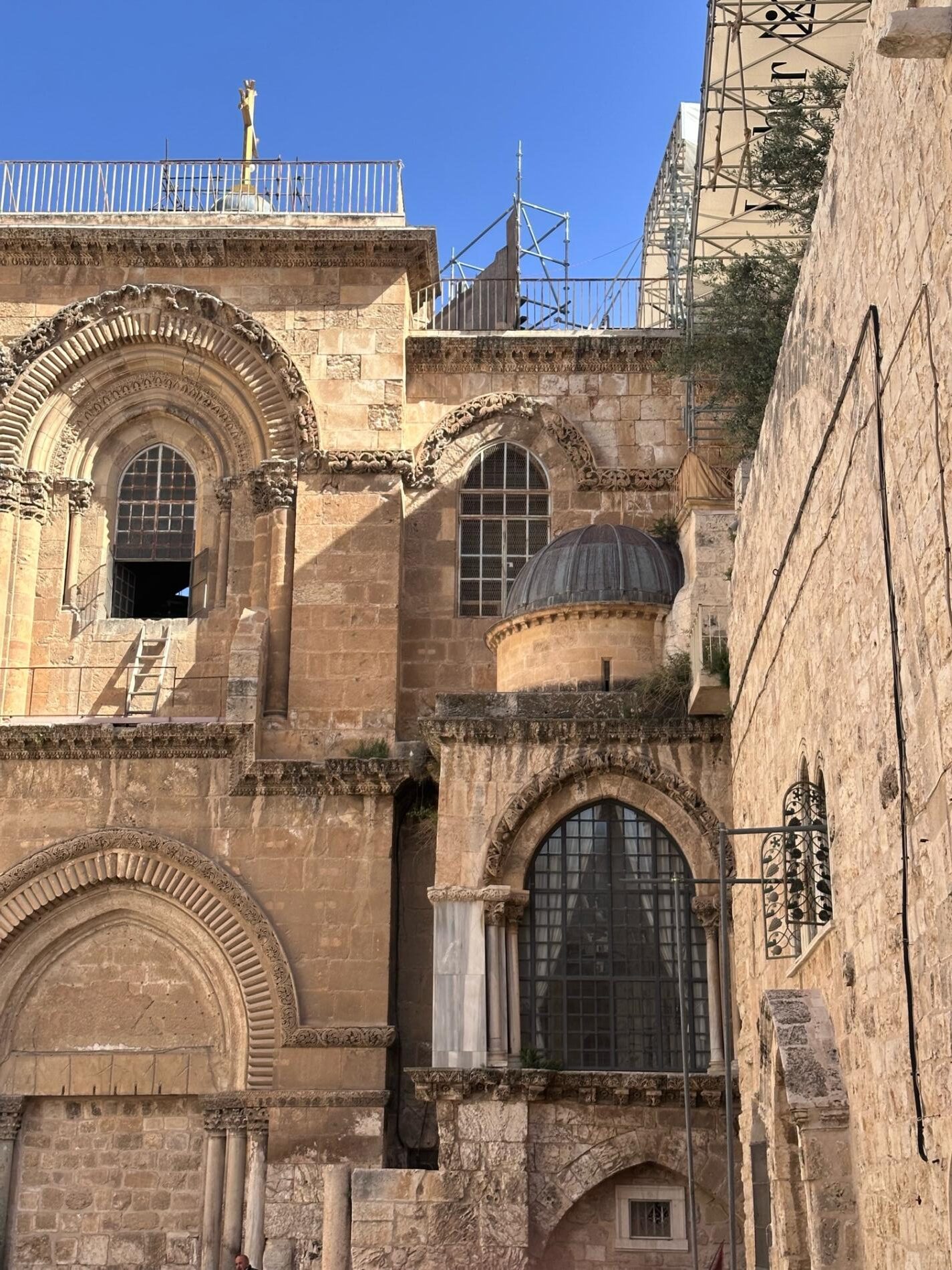
This is where Jesus was crucified. A cave next to the crucifixion site was his tomb. His body was laid out on a slab called The Rock of Anointment that still exists, where Christians pray, and rub, and touch convinced that by doing so a part of Jesus enters them.
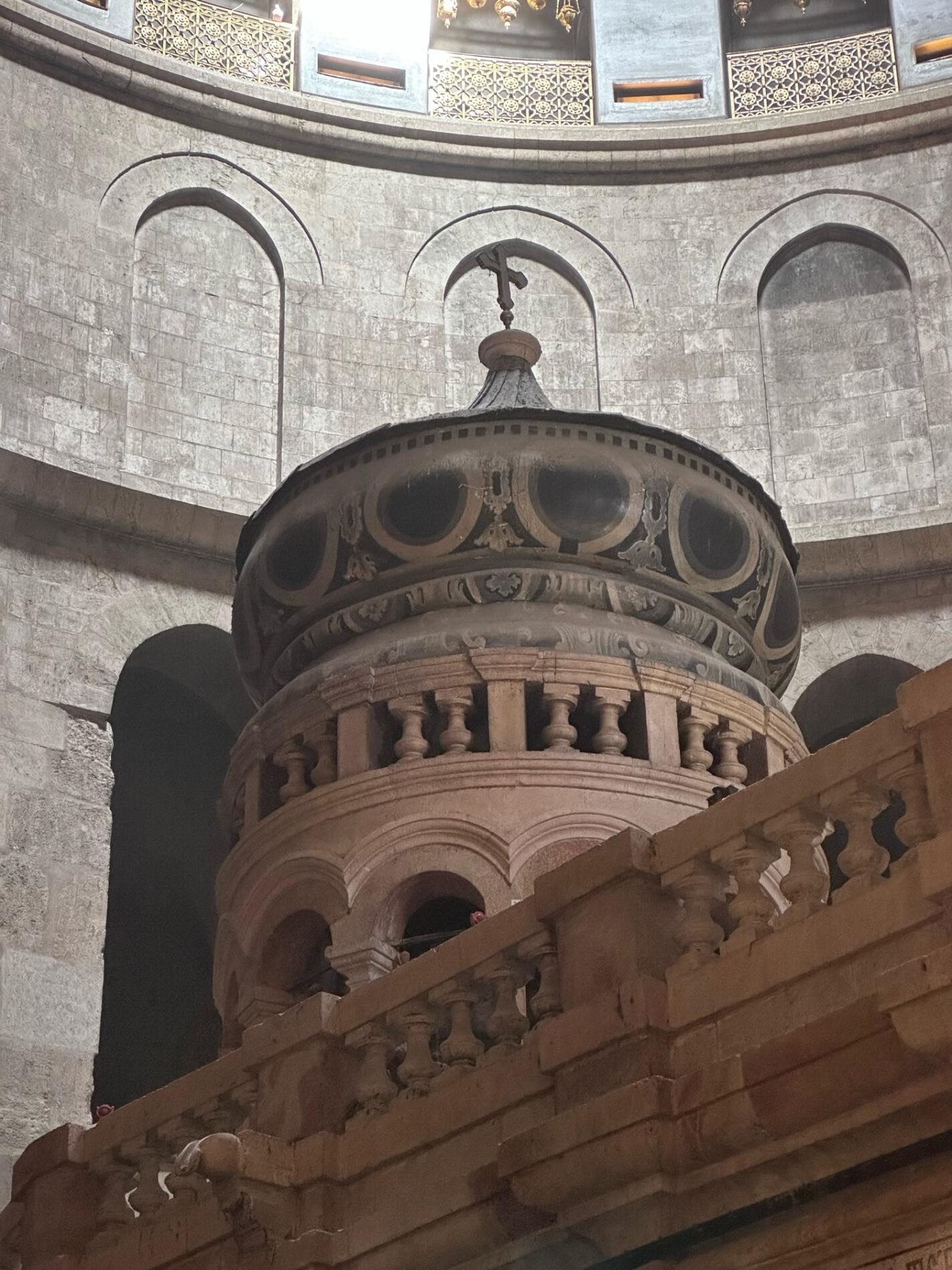
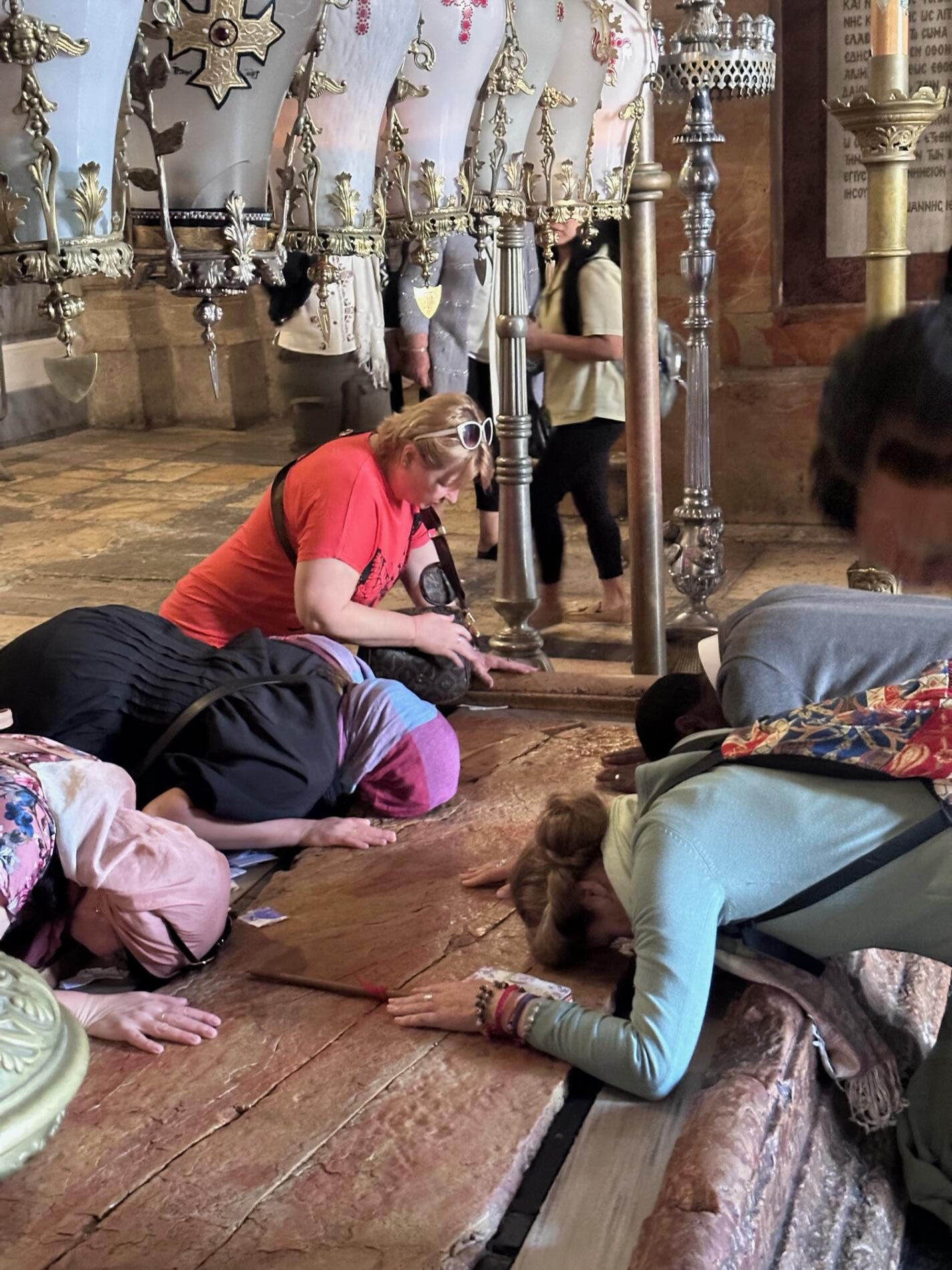
Jerusalem, Israel's capital, is rich in history, religion, culture and diverse peoples. Jerusalem is the spiritual epicenter for the world's three major monotheistic religions- Judaism, Christianity and Islam. During a walk through the Old City, the heart of Jerusalem for guests of all faiths, one can hear Jews praying at the Western Wall, church bells ringing from Mount Zion, and the wail of the muezzin, the Muslim call to prayer, from the El Aksa Mosque (El Aksa = the Edge). (There seems to be several ways to spell this. This spelling is Arabic.) This is the mosque that has been in the news of late as the site of recent troubles between Arabs and Jews.
Throughout the generations, empires have battled to become Jerusalem's gatekeepers. A visit to Jerusalem is like a walk through history books of humanity. The labyrinth of underground tunnels reveal secrets of the past.
Every alleyway seems to have a story, mostly about Jesus's journey to the crucifixion site.
The New City houses The Knesset, Israel's parliament, the surrounding government buildings, high-tech parks, renowned universities, luxurious hotels, chic cafes, award-winning restaurants, and state-of-the-art museums, all contrasting vividly with the Old City.
The Old City of Jerusalem, formerly a British mandate then, after 1948, Jordanian, was occupied by Israel during the Arab-Israeli war of 1967 and later annexed, a move not recognized by much of the world. The international community largely believes the old city should be given back to the Palestinians as their capital and the Israelis should get the new city. Not gonna happen and we saw why....the most sacred monuments to all three religions are basically, and sometimes literally, on top of each other.
The Israeli-Palestinian conflict is just the latest battle over ownership and land in a city that has been invaded and captured scores of times in its history.
Even a small monastery on top of the Church of the Holy Sepulcher, built in multiple phases beginning in 325 AD by the mother of Constantine the Great, St. Helena. Ethiopian Copts and Egyptian Monks are fighting over ownership, sometimes violently. This bit is from today's New York Times.
To keep the "peace," a Muslim holds the key to the church.
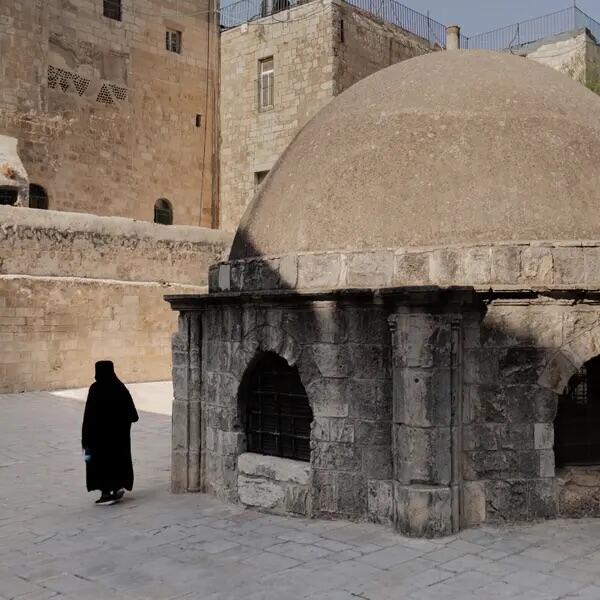
There are four "quarters" in the Old City. Christian, Armenian, Muslim, and Jewish. The Muslim Quarter is the largest. It looks like one big souk.
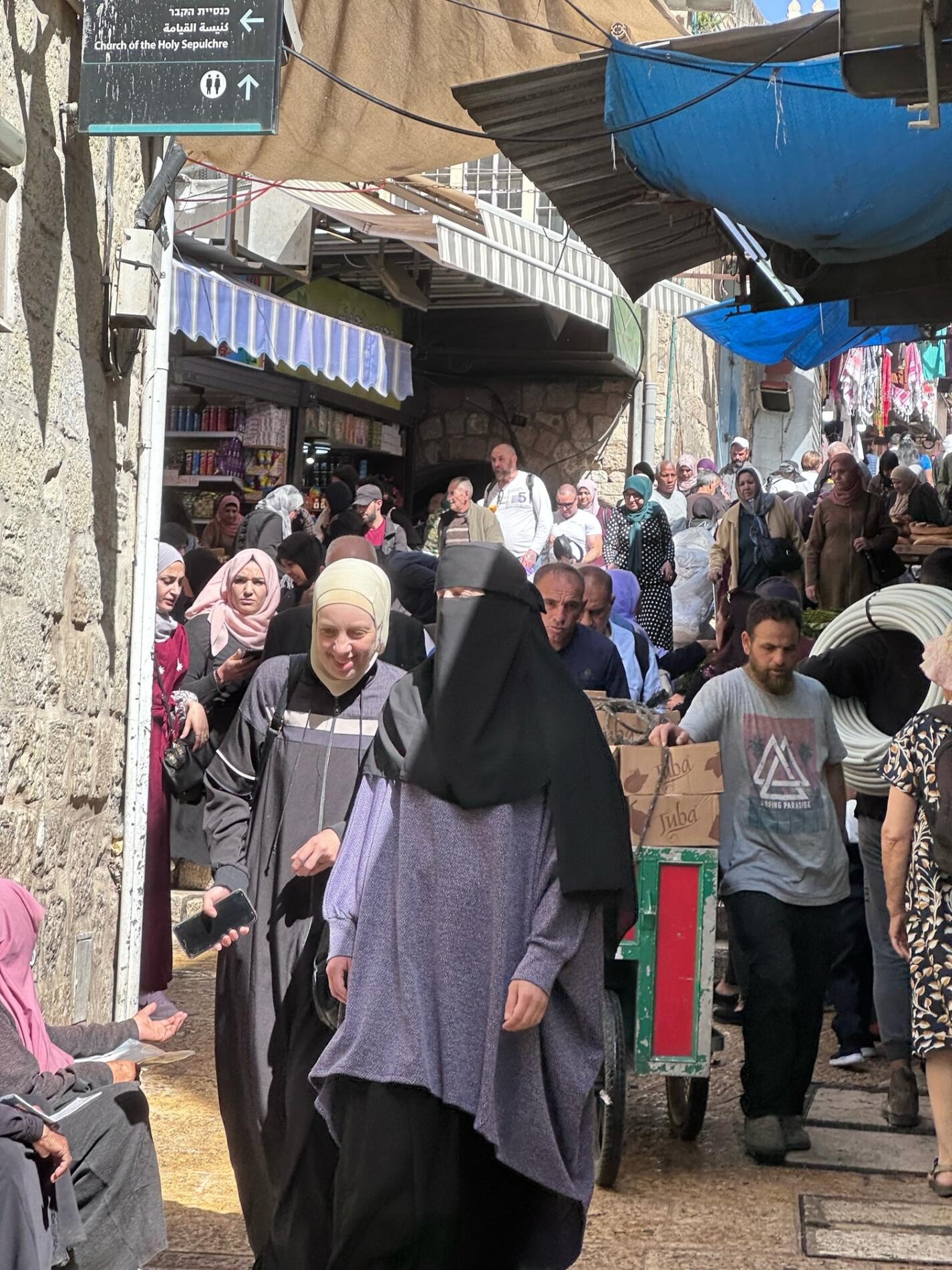
The Armenian Quarter is small. If you're wondering why the Armenians are included at all among the big three it's because they claim to be the first country to accept Christianity 301 AD. The Egyptians claim the same.
The Jewish Quarter
Four Jewish Sephardic Synagogues were built in the 16th Century but were destroyed along with the entire Jewish Quarter by the Jordanians in 1948. These synagogues were restored after 1967. The cantor sounds like a muezzin, very different from Ashkenazi cantors, since the Sephardic took so much from their Arab cultures. Men and women were segregated and separated by a screen. The rabbi and cantor face the men and have their backs to the women.
The Western Wall aka the Wailing Wall is among the most holy places to Jews. The Western and Southern Retaining Walls of King Herod's second temple were destroyed by the Romans. The Muslims built The Dome of the Rock in 692 AD on the exact spot where both Soloman's and Herod's Temples once stood. The Dome of the Rock is the third holiest site to Islam after Mecca and Medina.
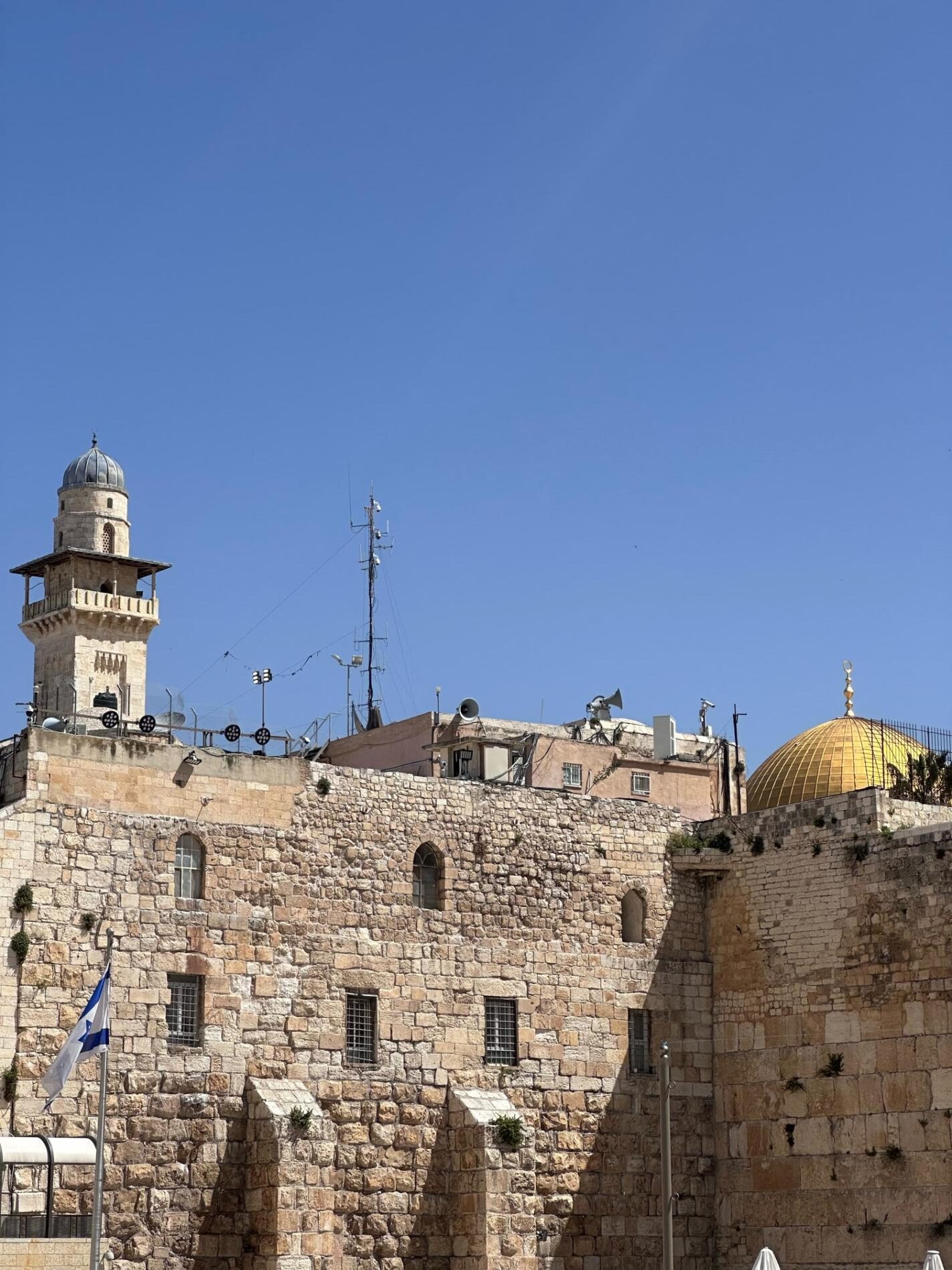
The Garden of Gethsemane is where Jesus prayed all night and was arrested. (Will send picture tomorrow)
In his will, Oskar Schindler directed to be buried in Israel. His grave is the one listing to the right.
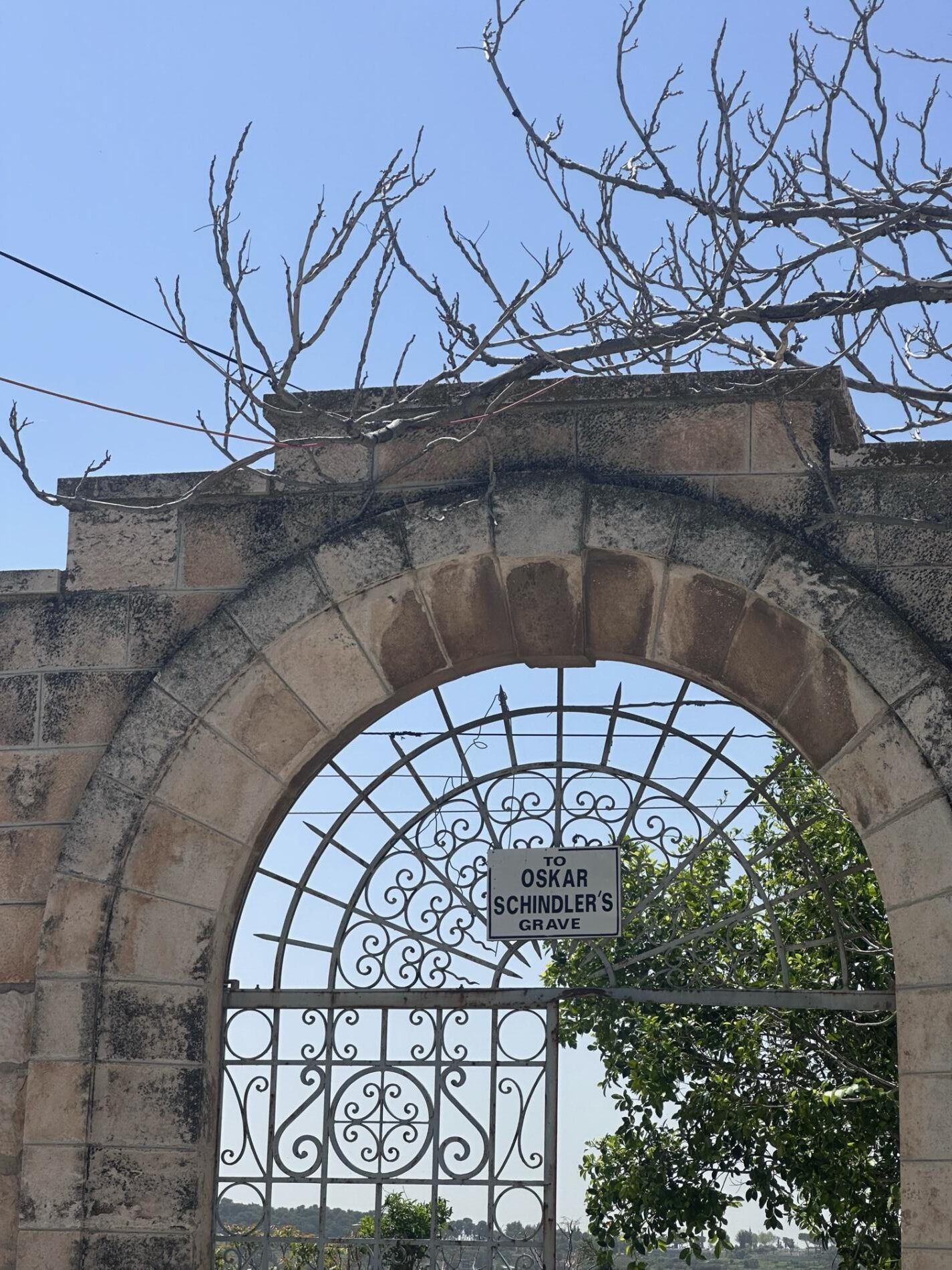
Still digesting all the info heard and sites seen today. It is a privilege to experience so much history.
Sicily, Italy
- At October 08, 2023
- By Jessica
- In Travel
 0
0
We have arrived in Italy! Arrivederci Halva, ciao Cannolis!
Sicily is the largest island in the Mediterranean Sea, famous for its wealth of
orange, lemon, and pistachio trees and, of course, olive groves .
To those White Lotus and/or Godfather fans the island is no stranger.
We docked in Messina on the Southern tip of the island. Messina is famous for the competition between allied generals during WWII to liberate Italy and, eventually, Europe. Patton won by a few hours. After 38 days of fighting the good guys were in.
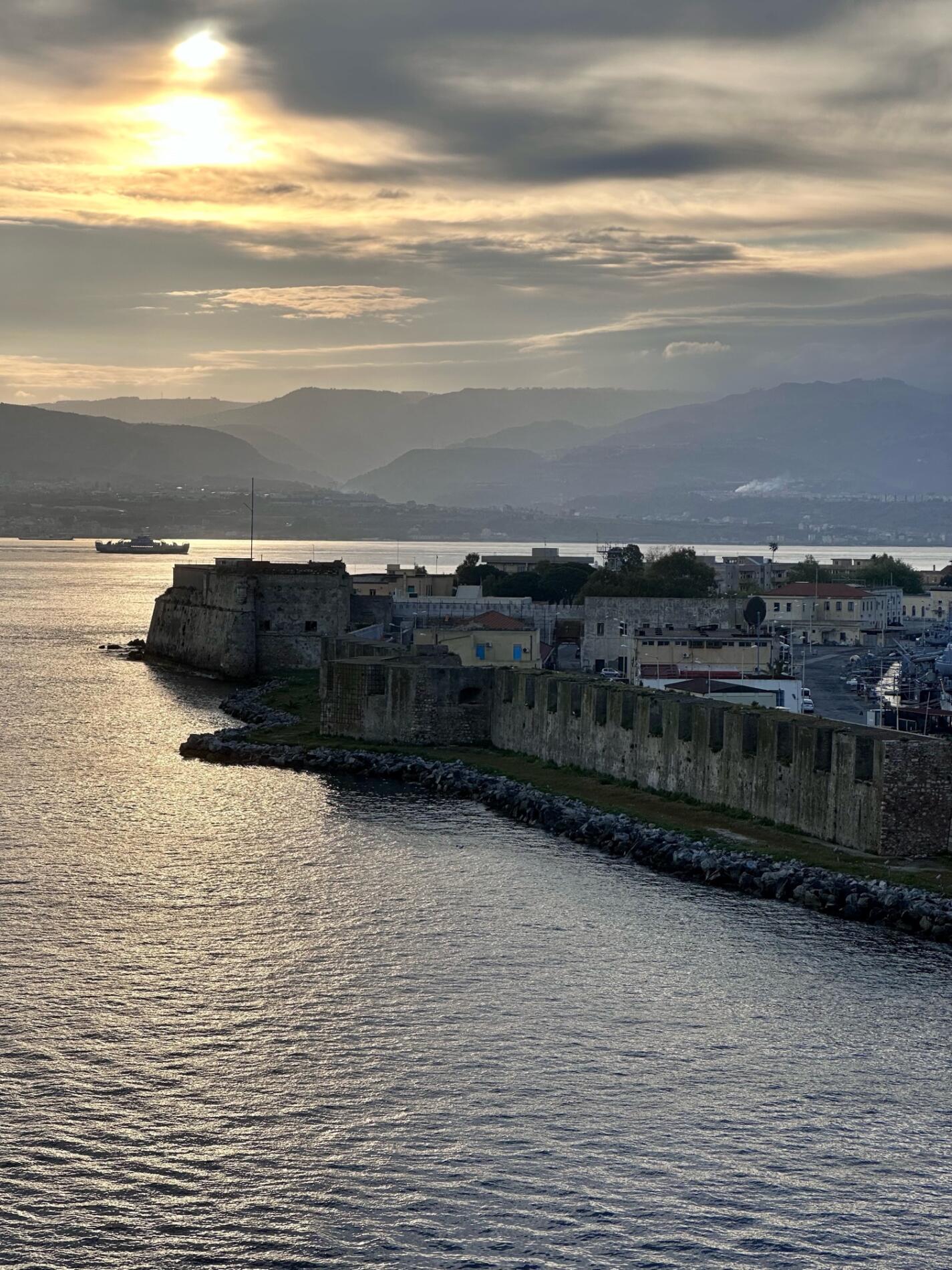
In 1908 Messina was destroyed by an earthquake and tsunami. 90 percent of the buildings were destroyed and the disasters claimed 60,000 human victims.
The area is famous for its seismic activity. There are five active volcanos in the south of Italy, including Mt. Etna, Stromboli, and Vesuvius. The latter is the one that wiped out Pompei.
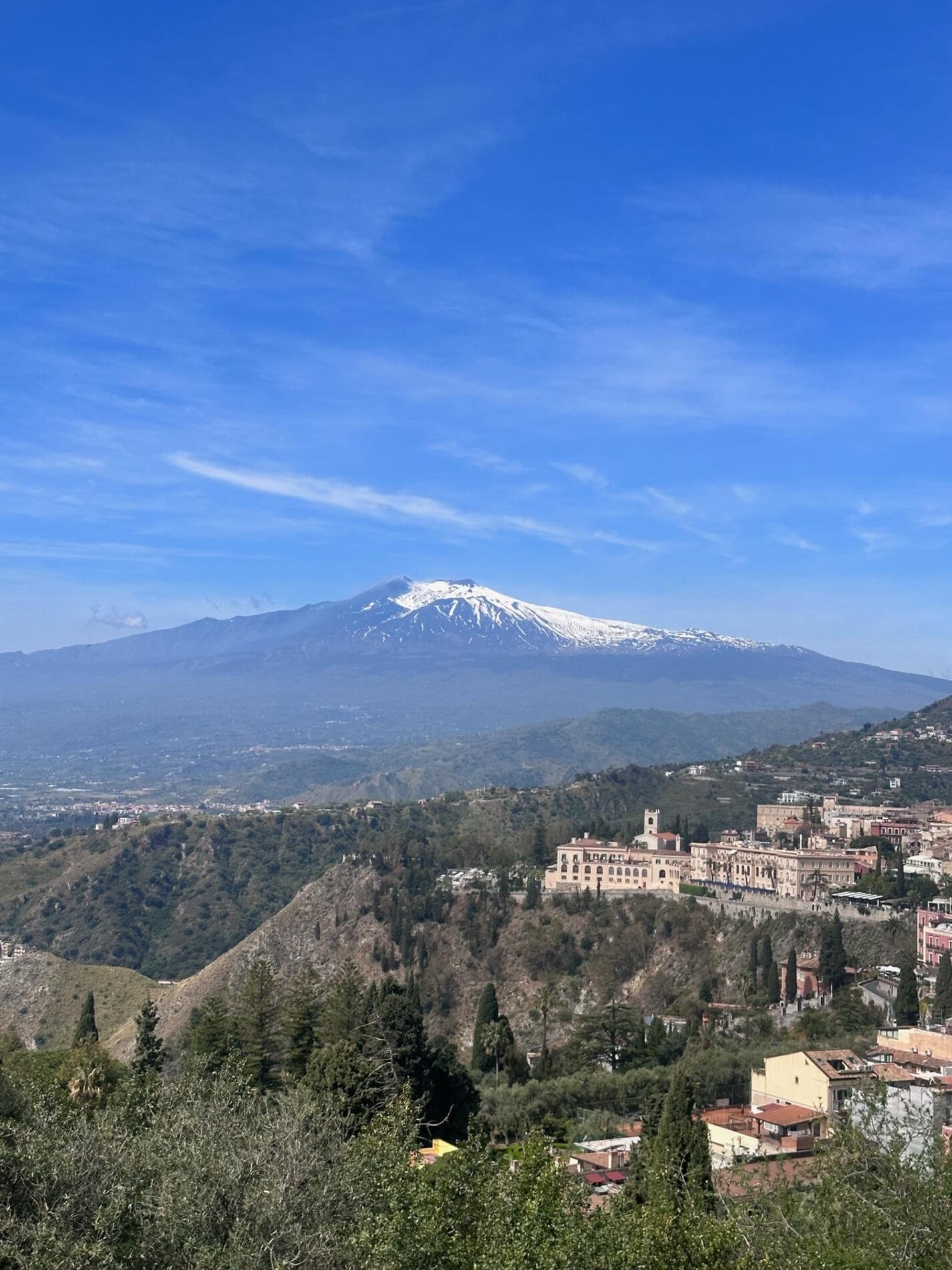
Taormina, about an hour from the coast, was named by Greece when they first colonized Italy in 734 BC. It was moved to its current location in 358 BC because Syracuse decided to conquer all the Ionian islands and destroyed the settlement on the sea.
Syracuse, in Sicily, was the birthplace of the great inventor and mathematician Archimedes. The "Archimedes Claw" lifted Roman ships right out of the sea as they attacked. Archimedes was killed by a Roman soldier. As he was dying he said, "don't disturb my circles."
The Taormina Greek theater was first built in the 3rd century BC. Because the theater was long abandoned, a family built a house next door during the 16th century and used the ruins as its garden.
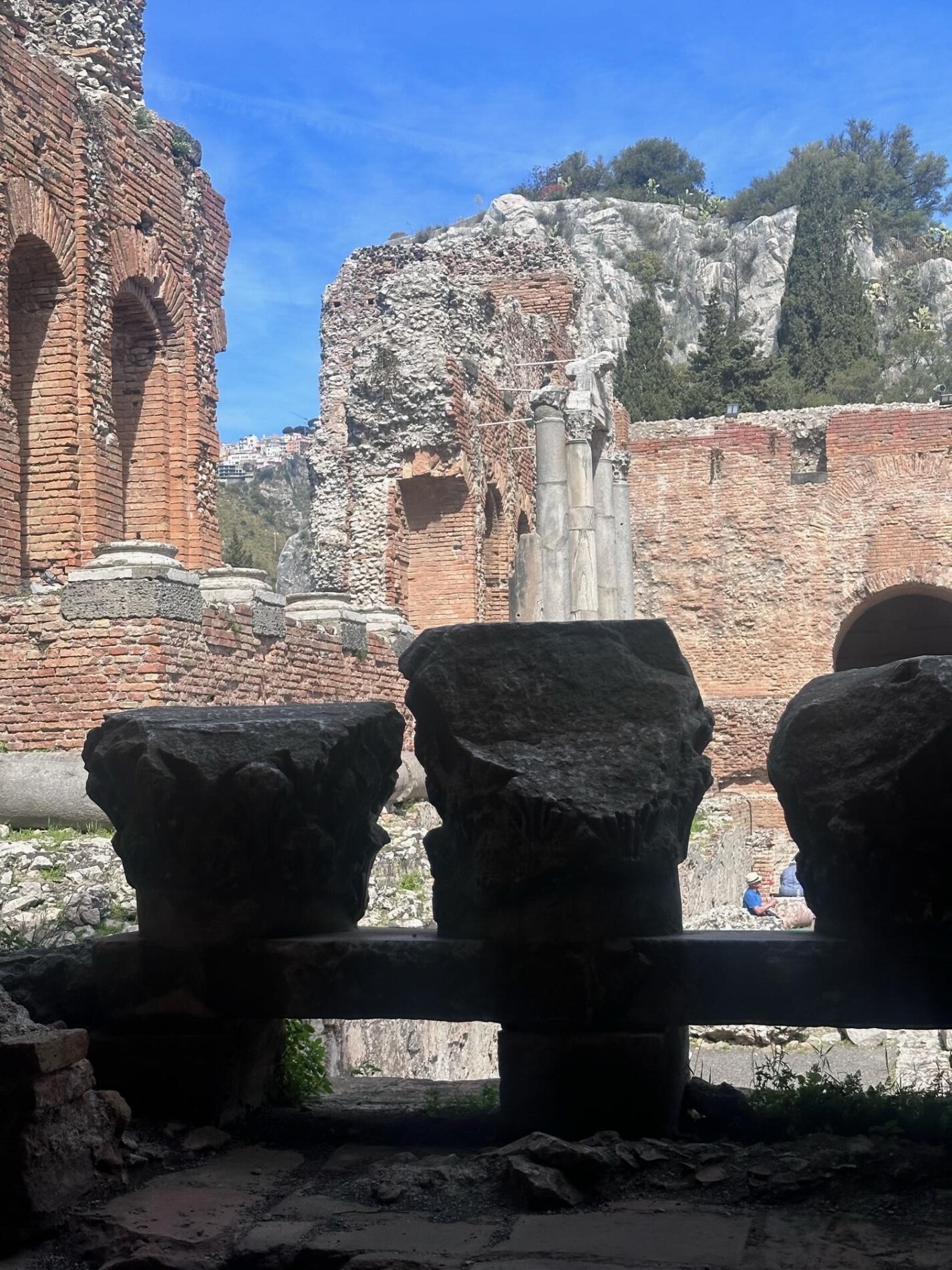
Native people lived here who were conquered by the Greeks, the the Greeks by the Romans. In 550 AD, Sicily was conquered and ruled by the Byzantines.
In 827 AD, the Ottomans conquered Sicily. Then the Franks and a few more in between the Spanish.
From 1309-1713, the Spanish controlled Sicily. Does all this conquering sound familiar?
These conquering influences can be seen in the architecture in Taormina.
There are Arab domes and moorish details on many buildings. Lava stone in contrast with white is known as the Sicilian Baroque style. In Catania, there's a whole street paved in black and white stone called Sicilian Baroque Street.
Sicily has a dark history of organized crime. Every cloud had a silver lining, in this case a silver screen. Without the Mafia we wouldn't have The Godfather movies! Or The Sopranos!
In Sicily, there is definitely an Italian coffee culture. No cappuccino after noon. So at 11:45 am sharp we sat down for the best cannolis ever and cafe latte to wash it down.
We then took a long drive up to the top of 10,000 ft. high Mt. Etna for a late lunch and, you know, go with the flow.
May-August is swordfish season when the Mediterranean is peppered with Felucca boats and fishermen.
The wine is fabulous in Sicily. It turns out lava ash is great for growing wine grapes. Who knew?
On this day in 1874, Guglielmo Marconi, son of an aristocratic Italian father and an Irish mother, was born in Bologna, Italy. In 1901 he sent the first radio signals across the Atlantic, ushering in the era of wireless communication. It could be argued that without Marconi you would not be receiving this message.
Ok. Who doesn't love Italy? Right, no one. Well, maybe her.

Con amore!
Jeddah, Saudi Arabia
- At October 01, 2023
- By Jessica
- In Travel
 0
0
For those of you who don't keep up with Muslim traditions, it is Ramadan as well as Easter. While we gorge ourselves with chocolate bunnies, provided by room service, our hosts are fasting. Viking has warned us no food or drinks while we are on land in Saudi Arabia.
We were also warned no touching (imagine us not being allowed to hold hands?), dress modestly, no porn (seriously?), etc. The ship cannot serve any alcohol while in Saudi waters.
As we pull in to port, the vast oil wealth is immediately obvious. Everything is modern, spotless, state-of-the-art. Not a scintilla of trash in the water.
Saudi Arabia's second-largest city, Jeddah has played a dual role throughout its history. Located on the eastern shores of the Red Sea, it was a major port for Indian Ocean trade routes starting in the seventh century. It also became a historically important gateway for Muslim pilgrims arriving by sea on their journey to the holy cities of Mecca and Medina, a role that continues to this day.
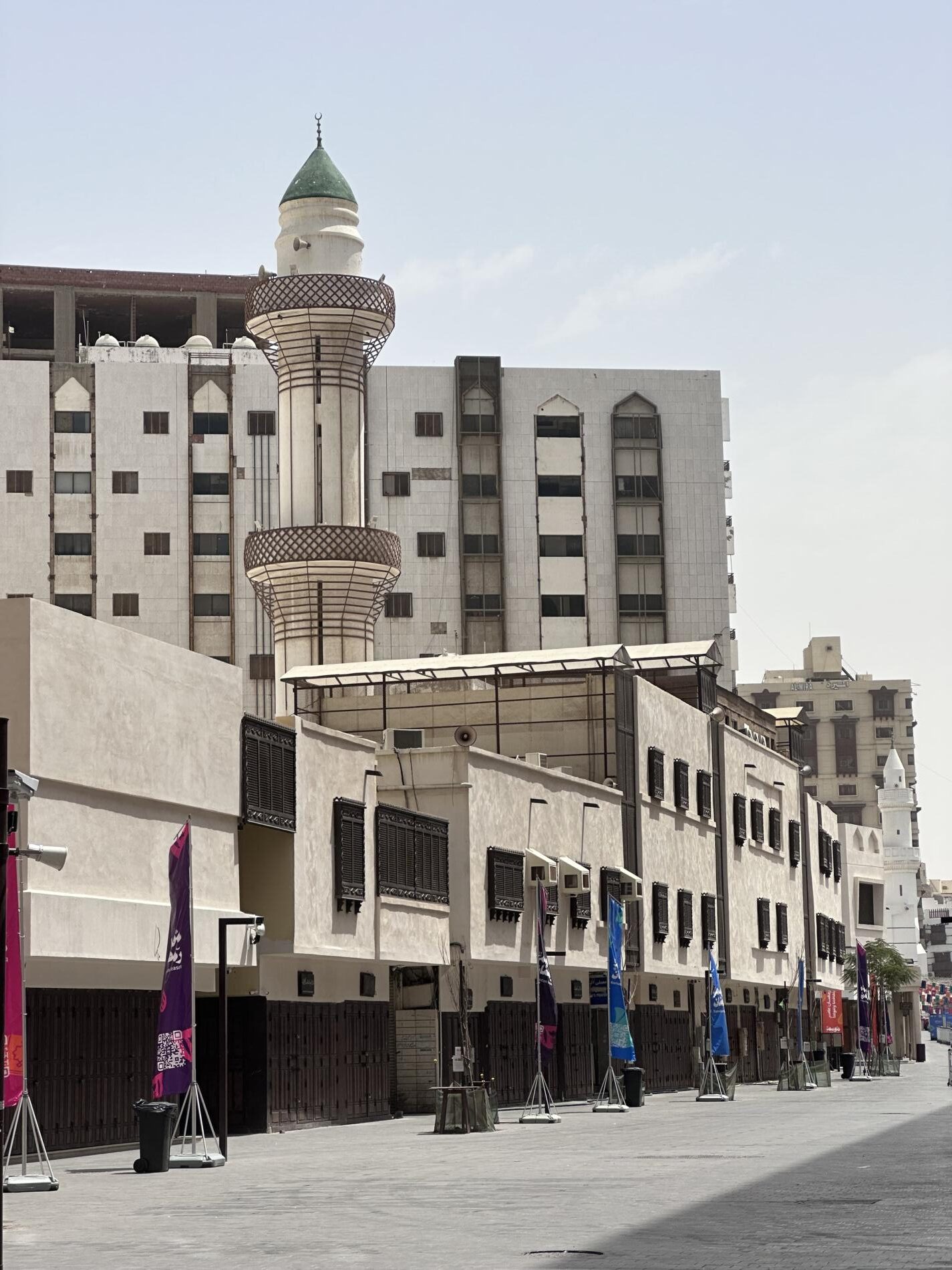
A modern multicultural city, Jeddah's heritage is evident as we took in the distinctive Red Sea architecture in the historic Old Town, Al-Balad. Surprisingly, there were no skyscrapers. Almost every building was the same height and beige, beige, beige. The city reminded us of one huge sand castle.
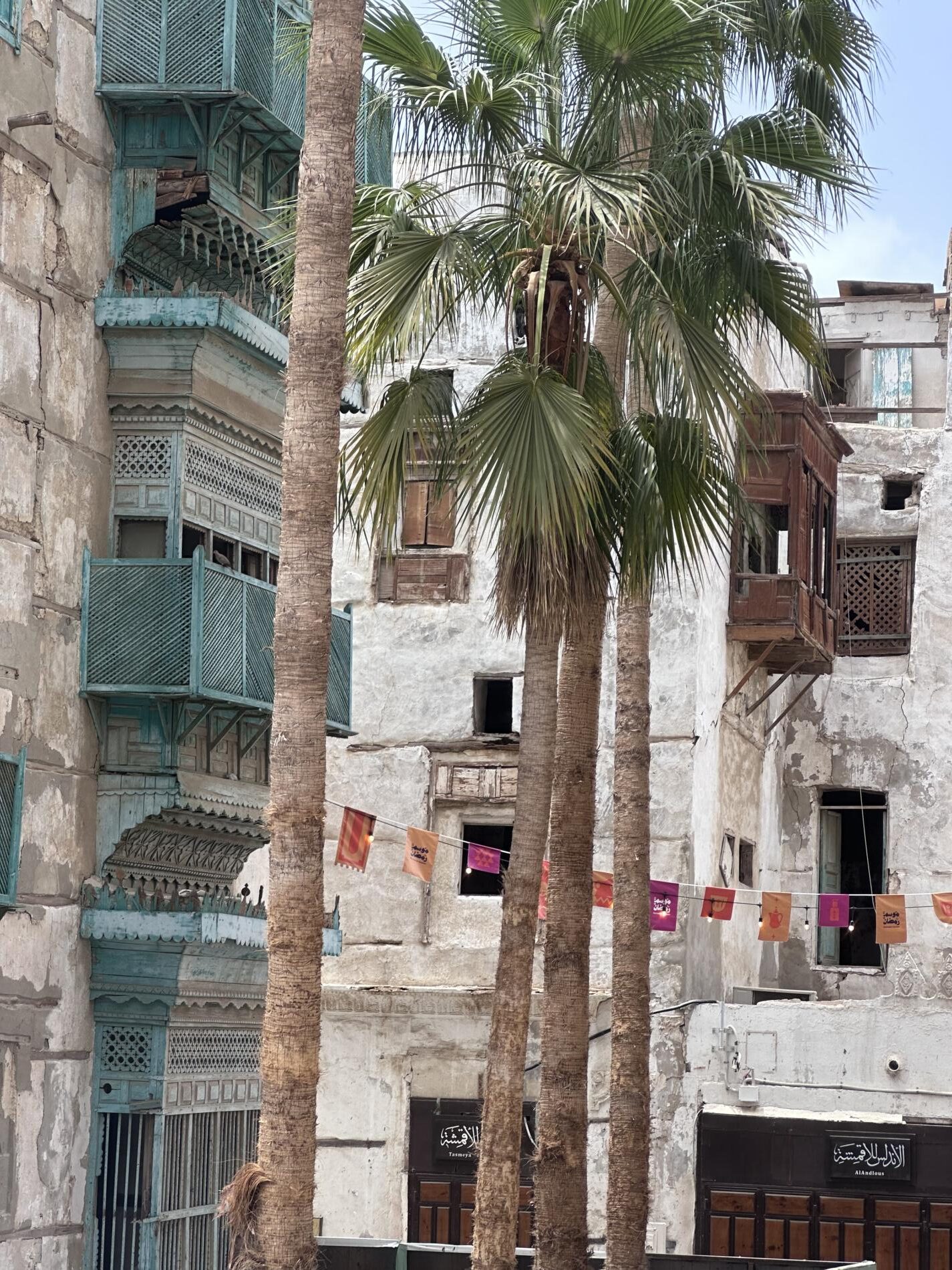
We were told Jeddah Tower, under construction, will be the "world's tallest" building, we saw the "world's tallest" flagpole, and the "world's largest" fountain. Frankly, underwhelming. Largest and tallest are not synonyms for best.
We drove along the Corniche, billed as the Champs Elysees of the Middle East. That's a stretch. It's a man made resort area with hotels including a Ritz-Carlton that looks like a Sultan's Palace.
Jeddah's history can be traced back to the Stone Age. We visited an old home that is now a museum, a mosque with a coral stone minaret that is 1,400 years old, and walked through ancient streets still part of everyday life. Jeddah was destroyed by the Portuguese in 1500, surrendered to the British Forces in 1916, then became independent in 1917.
About a week ago, Viking offered us a women-only tour. We were led to believe we would visit an authentic home to see how Saudi women live. Jessica went and, as she expected, it was a propaganda tour. The guide repeated points about how free Saudi women are, how they have equal rights to men, etc., etc. multiple times. When asked direct questions she was either evasive or misleading. A simple Google search confirmed that what she was telling us was concocted. This was a big disappointment. Although, in general, we found Jeddah fascinating.
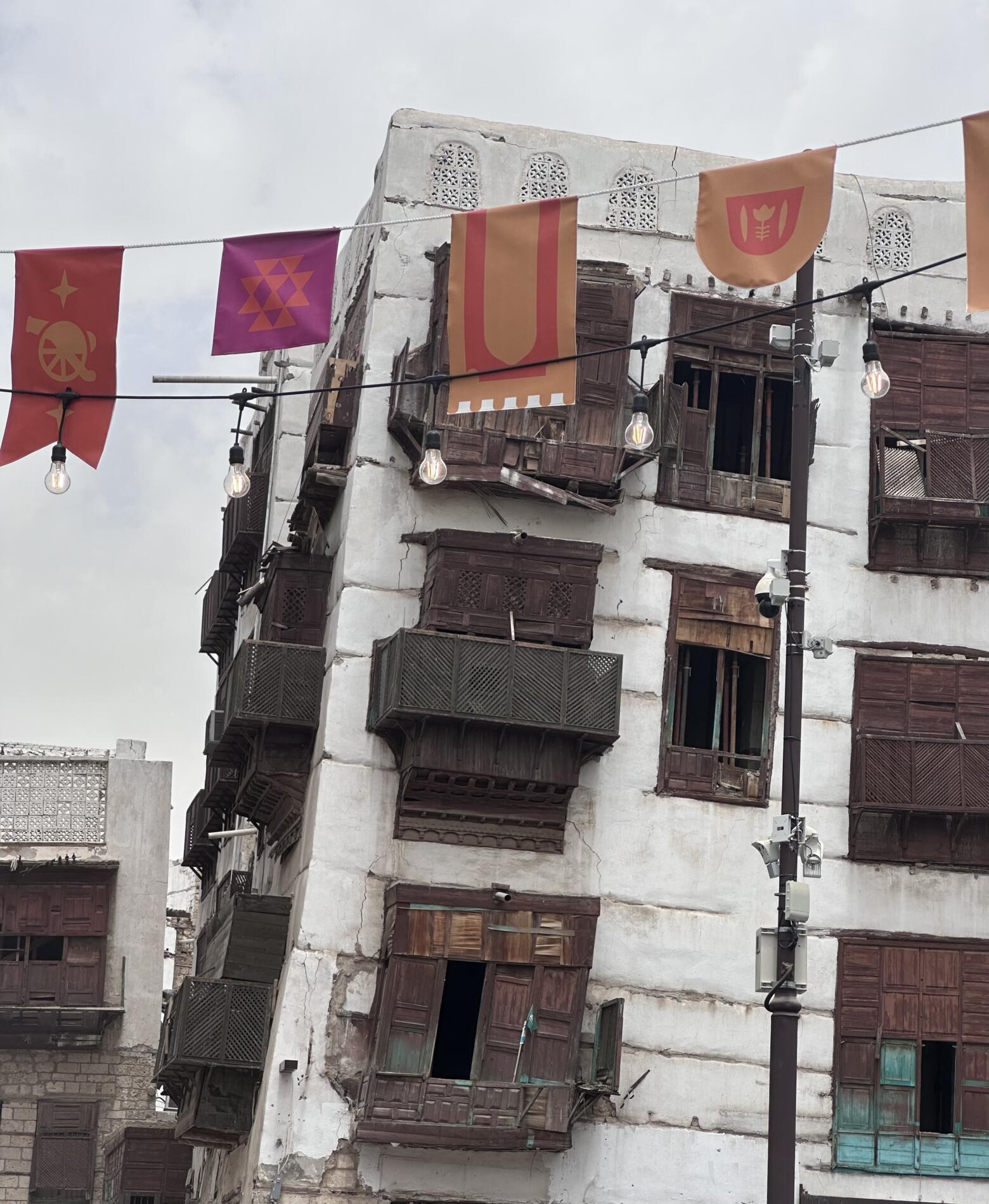
At the end of the day we are left with two conclusions:
- Saudi Arabia is the most foreign place we've ever been.
- Saudi Arabia Halva is the most delicious we've ever eaten.
Jordan, Part 1 – Aqaba
- At September 24, 2023
- By Jessica
- In Travel
 0
0
Jordan occupies a precarious place in the world. Its border with Syria is 180km, with Iraq 375 km, with Saudi Arabia 744 km, and with Israel, 350 km. Talk about being in the thick of it all!
Our ship docked at the port of Aqaba at dawn. Aqaba is located on the northeastern tip of the Red Sea and is surrounded by mountains and desert. Aqaba = Obstacle
With its central location between Africa and Asia, Aqaba has played a significant role in the region's trade for thousands of years. Today, its prosperity rests in its position as the sole port of the nation.
In 1917, T.E. Lawrence (known as Lawrence of Arabia) led troops in the Battle of Aqaba here. The white-robed Englishman helped the Arabs run the Turks from the city's fortress during a camel charge. Famously, Lawrence used nearby Wadi Rum, a vast desert canyon, as base camp during the campaign.
Emerging from the cruise port to meet our guide at 8 AM, we thought we had landed on the moon. Having never been to the moon -yet - Jordan is most like Monument Valley in Arizona of the places we have been. (Elon Musk be damned, we are waiting for a Moon Cruise.)
The actual town of Aqaba is a pretty few block strip of new hotels, fast food restaurants, and shops. The investment money comes from China.
We headed north to the ancient city of Petra. For the longest time, all we saw were craggy mounds of rock shaped by centuries of wind and weather.
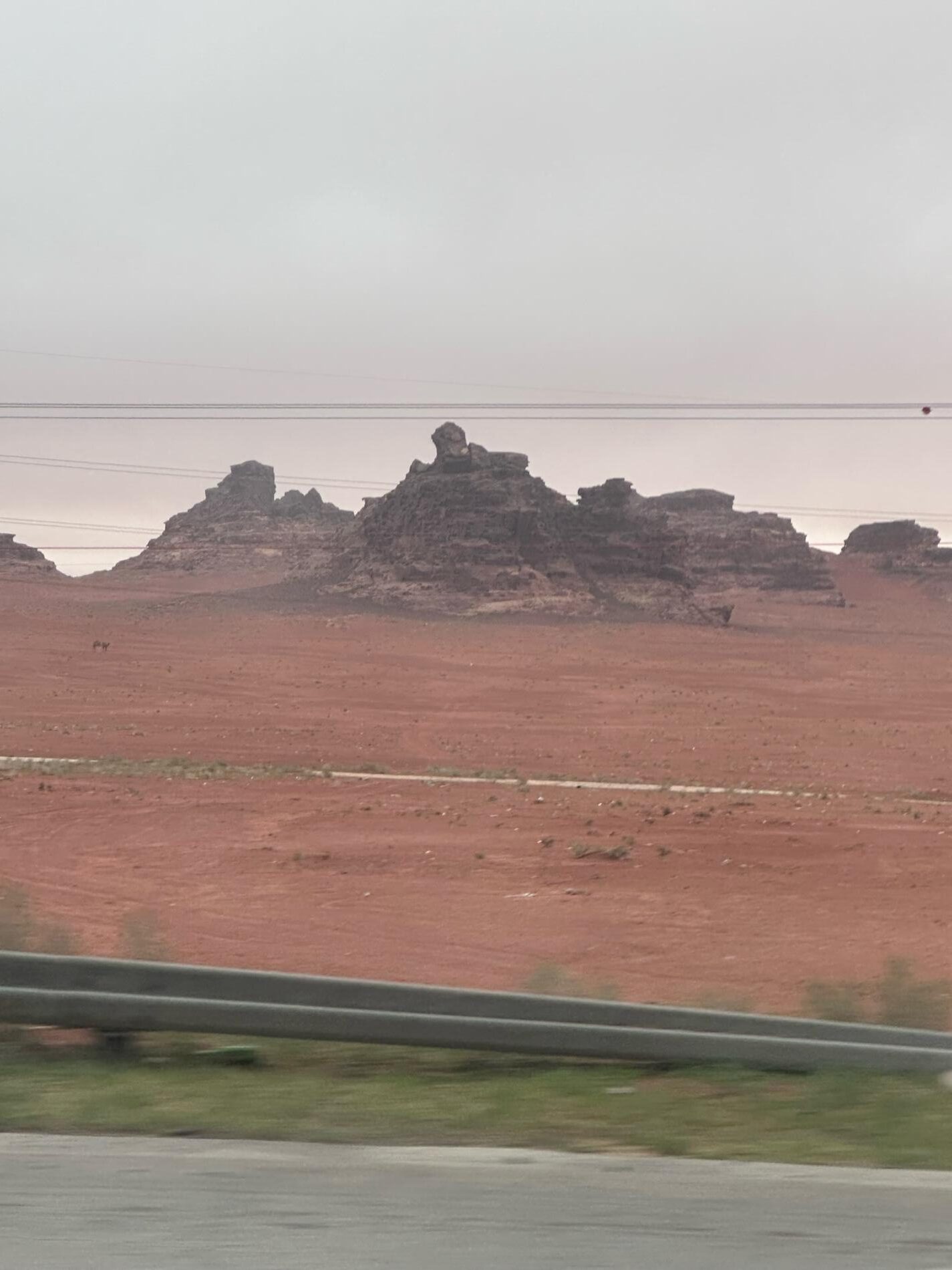
Speaking of which, it is only 60 degrees today. Drastic drop from 95 degrees in Saudi Arabia. And foggy. It was so foggy, in fact, that we witnessed a multi-car pile-up on the road to Petra. This road is called "orphanage valley" due to lots of accidents. So glad we have our own driver
It snows in Jordan, especially in Amman and Petra. Did you know that? We didn't.
We passed random camels on the side of the road, just like the deer we pass on Route 95.
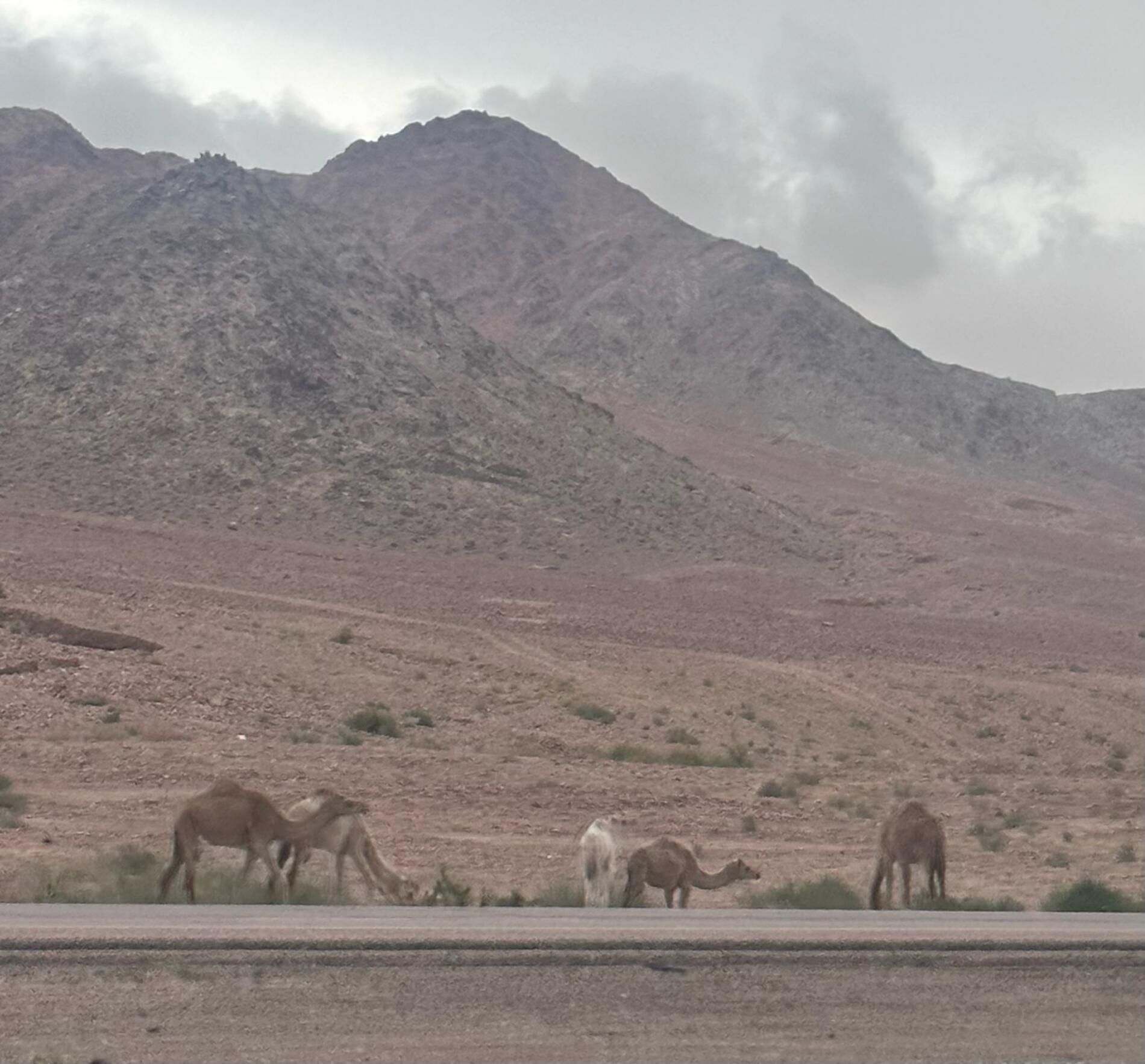
Next we passed by Wadi Rum, where Lawrence of Arabia lived while fending off the invading Turks, as mentioned above. Now it is a nature preserve where many sci-fi movies are filmed. Wadi Rum = Rock Valley. Also called Moon Valley.
Fun Fact: The Dead Sea, between Israel and Jordan) is the lowest point on Earth at 400 m below sea level.
The city of Amman is surrounded by 21 mountains and when the muezzin calls for prayer it echos across all the mountains.
Fun fact: The second name for Amman is Philadelphia.
From Wadi Rum we took the Jordan Trail to Petra. We were well prepared by a friend who recommended we read I Married a Bedouin, the true story of a New Zealander who married a tribesman.

Egypt, Luxor and Karnak – Part 2
- At September 17, 2023
- By Jessica
- In Travel
 0
0
Called the "Hundred-Gated City" by Greek Historian Homer, Luxor is set on the east bank of the Nile River. It is a pretty city with a French flavor. The city was once known as Waset, then as Thebes, now as Luxor, which means "City of Palaces" in Arabic. As Thebes, it served as the capital of Egypt's "New Kingdom." Today, the Nile hugging promenade of the City is lined with beautiful colonial hotels and some of the world's most ancient and significant ruins. Many consider this city, watched over by graceful single-sailed feluccas plying the Nile, one of the world's great open air museums. In the center of town, the vast ruins of the Temple of Luxor, dating back to 1392 BC, sit like the Plaza Hotel does in New York - just part of the scenery! The sprawling Temples of Luxor and Karnak on the east bank are linked by the ancient Avenue of the Sphinxes.
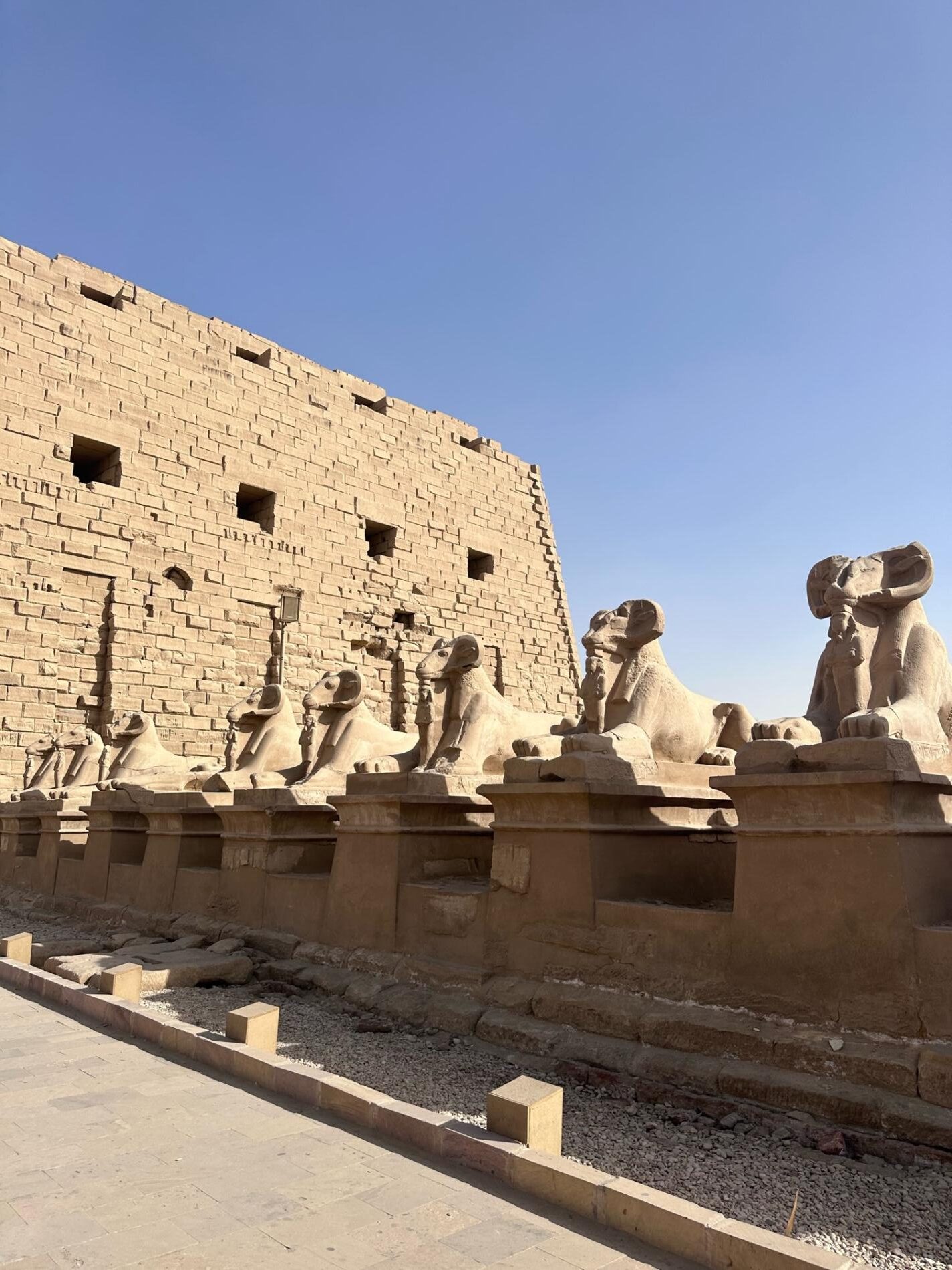
Ram head = health
Lion body = symbol of power.
On the west bank, in the Valley of the Kings and the Valley of the Queens, lie the tombs of Egypt's great pharaohs. The ancient Egyptians stopped building pyramids as royal tombs after thieves stripped them bare opting instead to bury their royalty in secret tombs in Thebes, today's West Bank of Luxor.
To walk among these testaments to time, history, and civilization is a profound experience. To stand, perhaps, in the same spots where Ramses II, Julius Caesar, Mark Antony, and Cleopatra may have stood.
During the time of the 18th dynasty, when Akhenaten was pharaoh, approximately 1351-1334 BC, he changed the religion from polytheism to a monotheistic system worshiping only the God Aman-Ra (God of the Air and the Sun). He created a holy triad: Aman-Ra, Mut, Khnoso, with Khnosu being the moon god and Mut being the sky goddess. Think about that - Akhenaten was the inventor of monotheism. The Egyptians have a theory, so far unproven, that Joseph of multi-colored coat fame, and known to be vizier to a pharaoh around this time, may have planted the idea of monotheism in Akhenaten's mind. Some Egyptologists believe that Joseph and Akhenaten were the same person! Anyway, Akhenaten made Karnak the center of religion but the Egyptian high priests didn't like this new idea of monotheism and ran Akhenaten out of town. He reestablished his kingdom in Amarna. The high priests hunted him down and murdered Akhenaten and destroyed Amarna. The renowned beauty Nefertiti was his wife. Nefer = beautiful one Titi = her name. (The wife of Ramses II was Nefertari - more on her later.) Akhenaten and Nefertiti had no sons, only two daughters. One daughter was married to nine year old King Tutankhamen. After killing Akhenaten, the high priests put King Tut in the position of King, moved the capital back to Luxor, where Tut ruled for ten years. He was controlled by the priests who killed him when he came into adulthood.

What followed was, in essence, a religious coup, placing a former high priest as Pharaoh - King Ay. An army general, Horemheb, killed King Ay and became King. In essence, a military coup. The son of Horemheb was Ramses I. King Siti I, whose tomb we describe in Part 3, was the son of Ramses I. Successive kings were from the military, including the famed Ramses II who reigned for 67 years and died at age 90.
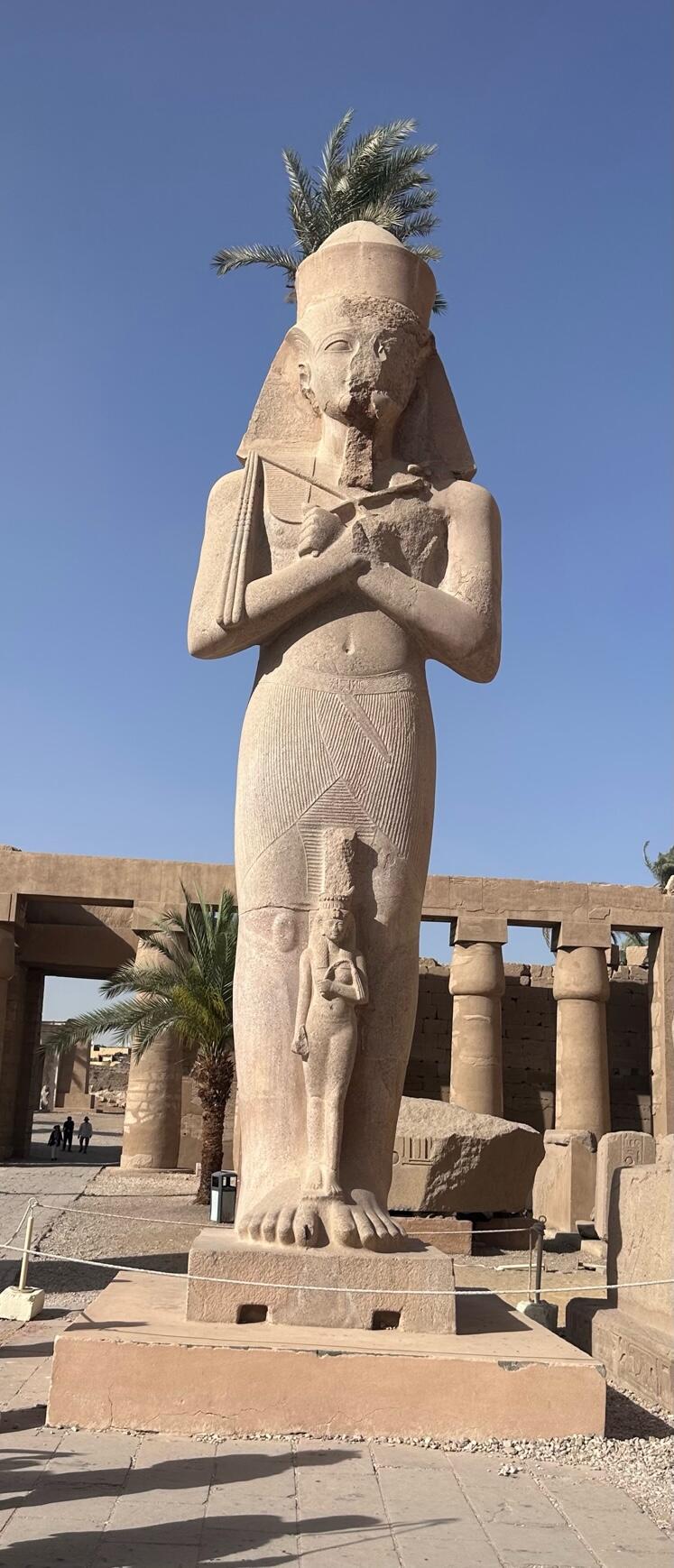
Ramses II was married to Nefertari who was Nubian. Ramses II was the most famous of the 11 Ramses. Ra = (sun god) msw = beloved one. He "dethroned" the high priests, constructed many buildings and monuments, had 53 wives, 111 daughters and 67 sons.
Karnak Temple was built over 2000 years by generations of pharaohs. The 62-acre Temple of Karnak was dedicated to the god Aman.*
* Alternate spellings are Amon, Amon, et al. Same god.
The great " Hypostyle Hall," a colonnaded court for priests and nobles, is a forest of 134 giant pillars. It takes your breath away.
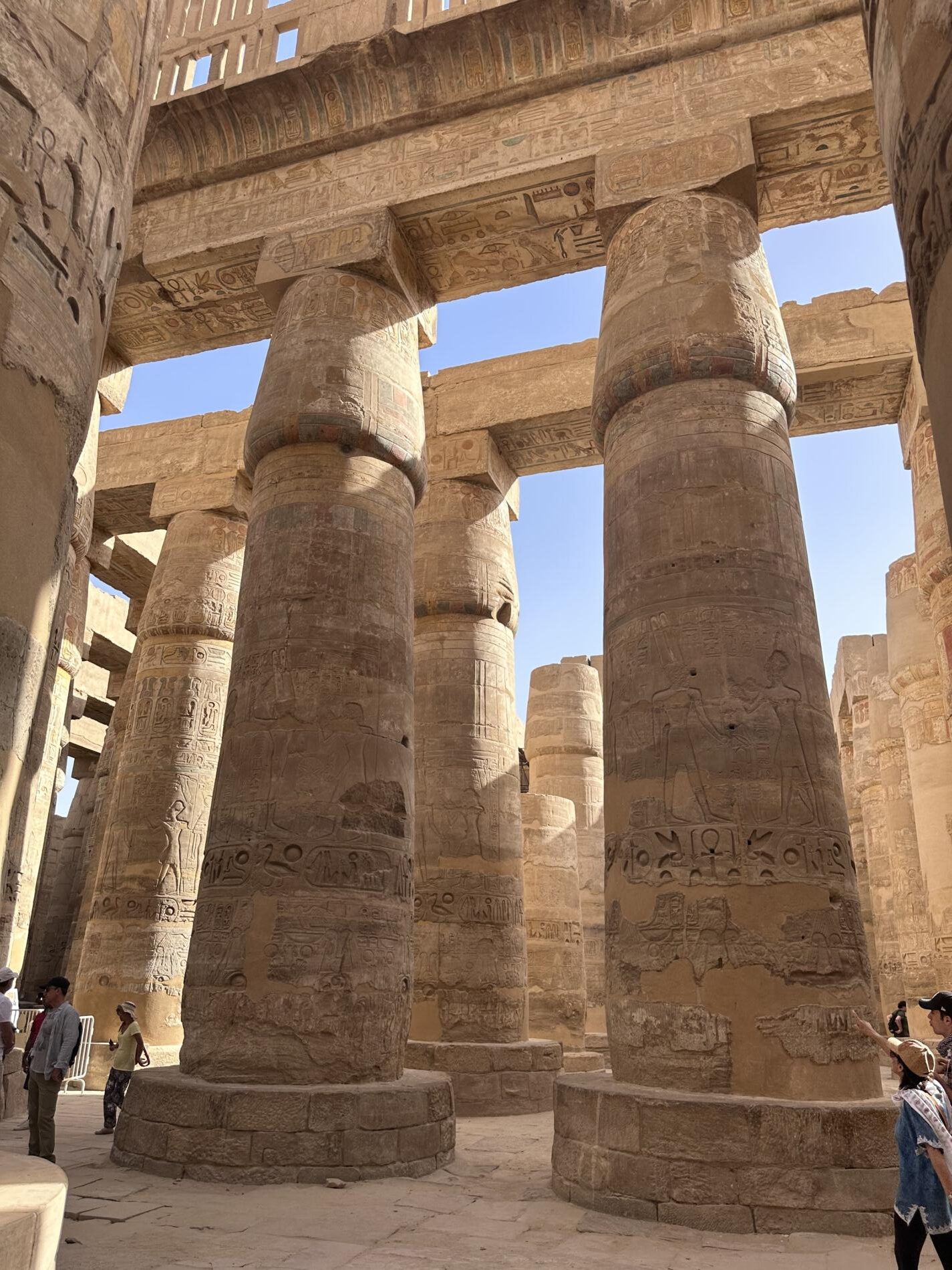
There is also a section of the temple for commoners to make their offerings and a Sanctuary only for the high priest and the Pharaoh where they present the offerings collected from the populace to Aman-Ra.
Fun Fact: Straight beard on iconography means king is alive. If curved beard king is dead.
Fun fact: Each cobra in iconography represents a kingdom. One cobra, king is from one part of Egypt. Two cobras, the king is ruling both north and south Egypt. Three cobras, the king rules north and south Egypt plus Nubia/kush.
The Ankh, which is omnipresent, is a symbol of long life and eternity.
Egypt in a Nutshell
- At September 10, 2023
- By Jessica
- In Travel
 0
0
Some of you may know that Jessica is working on a new novel called The Goddess Conference. Parts of the book take place in biblical times throughout the Middle East and a sizable chunk takes place in ancient Egypt. This part of the cruise is especially important because writers need to see, hear, touch, smell, and taste what they are writing about to be credible.
Egypt is bordered on the north by the Mediterranean, on the east by the Red Sea, Gaza, Israel, and Palestine*, in the west by the Sahara Desert, Chad, and Libya, and in the south by North Sudan and Nasser Lake, the largest artificial lake in the world created by the building of the Aswan Dam in 1971. Egypt is a beautiful country, far greener and more bucolic than Jordan or Saudi Arabia. A palm tree paradise.
We disembarked just before 8 AM. We were met by three people for our private tour: a PhD Egyptologist called Wael, whose English is perfect, a tour coordinator, and a driver.They were very happy to hear Jessica is 31 percent Egyptian. She wore her hajib. On our 145 mile journey to Luxor, which included dozens of security checkpoints and armed "tourism police," we passed lots of desert, home to gold and silver deposits including a 3500 year old gold mine from the time of the Pharaohs. We then passed by multiple farming villages where they grow sugar cane, wheat and alfalfa. The farms are irrigated by a natural tributary of the Nile. After the Mississippi, the Nile is the world's longest river. (Sorry Jeff Bezos, not the Amazon.) One of only a few rivers on Earth that runs south to north, its importance to the survival of Egypt is legendary. Due to the Nile's reverse flow, Upper Egypt is south (represented by the lotus) and Lower Egypt is north (represented by the papyrus.) We highly recommend the book River of the Gods by Candice Millard about the search for the source of the Nile. Non-fiction that reads like a thriller.
Fun fact: We see so many unfinished occupied houses without roofs. Why? Because no roof, no real estate tax.
Luxor's population is approximately 320,000. They enjoy special status as the "real Egyptians." 65 percent of all Egyptian treasures of antiquity are found in Luxor. This represents 32 percent of all the treasures of antiquity in the whole world. Wow! Even more amazing is that 68 percent of what is estimated to still exist has not yet been discovered. Our tour guide said he remembers eating at many restaurants in Luxor that are gone because the earth they sat on was concealing the Avenue of the Sphinxes or other antiquities and has since been excavated.
Even small villages have multiple mosques. All the women we saw are dressed devoutly in full burqa. Egyptians love to eat meat on Thursdays year round. Lots of pop-up butchers.

Here's 7000 years of history compressed into a virtual thumb drive:
The history of Egypt is broken down into dynasties. This really means periods, not specifically ties to royal dynasties as we understand them.
Pre-dynastic Egypt of 7000 years ago was a grassland coming out of the Ice Age. It got progressively drier until only the Nile River Valley supported life.
Dynasties 1 - 3 represent the "Early Period" starting 5000 years ago. The first Pharaoh was King Minie who united the two "countries" of Egypt into one.
Dynasties 3-7 began at the end of the third dynasty around 2,500 BC with King Joser. This marked the beginning of the "Old Kingdom." It was also known as the "Pyramid Period" and was based in Giza.
The 8th - 10th dynasties, from 2500-2200 BC, represented the first of several "Intermediate Periods" marked by inter family fights and invasions that weakened Egypt.
Dynasties 10 -15, from 2200 - 1800 BC, were known as the "Middle Kingdom." It was based in Amarna.
The 16th - 17th dynasties from 1800-1150 BC represented another "Intermediate Period," when Egypt was weak. This was the time when the Hyksos tribes invaded Egypt from Asia.
The 18th dynasty, from 1520 BC started the "New Kingdom." This was considered the Golden Age of Egypt and encompassed the 18th-20th dynasties. This period ended in 1200 BC.
Another "Intermediate Period, Dynasties 21 and 22, lasted 200 years. 70 kings ruled Egypt together for 70 days trying to contain the conflicts until 1000 BC.
During these conflicts, Egyptian Kings captured Libyan and Nubian tribesmen and forced them to be soldiers. Ironically, this gave rise to the Libyan Dynasties, 23-24, for 250 years up until 750 BC. Give a guy a sword and teach him how to use it and eventually he'll use it on you!
Along the same lines, Dynasties 25-27 were dynasties with Nubian Pharaohs.
Dynasties 28-30 are considered the "Late Intermediate Period," which suffered many invasions by the Persians who ruled Egypt from 750 BC - 332 BC. This is known, appropriately, as the Persian Age.
In 332 BC Alexander the Great from Greece said to the Egyptians, "I will save you from the Persians." He ruled Egypt from 332 BC - 323 BC. Alexander founded Alexandria (after himself of course) and created there a master library in Greek, which attracted scholars from the entire empire. This marked the end of Dynastic Egypt, the end of the Pharaohs, and the beginning of the Greco-Roman period in Egypt. The Greeks had 13 King Ptolemys and one lady Pharaoh - the famous Cleopatra (who was actually Cleopatra #7). The Greek period lasted for 180 years. See below for why the Greek period ended....or read about it in your copy of the Rosetta Stone.
The Roman period began with Mark Antony in 117 BC and lasted for 365 years. When the Romans ruled they defaced all the monuments of the Pharaohs. In 42 AD, Saint Mark (no relation to Mark Antony) brought Christianity to Egypt because he and other followers of Jesus were persecuted by the still polytheist Romans. Egypt was a Coptic Christian country from 41 AD - 641 AD while still a part of Roman Empire. Between the last Roman King in 280 AD and Ottoman rule from 1778-1980, Egypt was ruled by a succession of Royal Muslim Families, mostly from Iraq. The French briefly occupied Egypt from 1799 -1802 during which time they discovered and later deciphered the Rosetta Stone (more on this later) and the English defeated the French in Alexandria. Egypt was a British Protectorate from 1882 - 1952 with a sultanate. In 1952 King Farouk was king of Egypt and Sudan and the last King from the Ottoman time. He was deposed by the Egyptian military, in a revolution led by Nasser. Muhammad Naguib, whose mother was from Sudan, was Egypt's first president, but only served a few months before being arrested by Gama Abdul Nasser, who "served" as Egypt's president from 1956-1970. Sudan was so furious about the ouster of Naguib that they seceded. From 1952 - 1970 Nasser, a "hidden" dictator, was kept in power with military support. Nasser expelled all the Jews and nationalized their businesses as well as the Suez Canal, which resulted in a war in 1956. We strongly recommend the book Out of Egypt by Andre Aciman for more on this subject. When Nasser died of a heart attack, Anwar Sadat became president of Egypt from 1971-1981. When Sadat was assassinated, 1981-2011 Hosni Mubarak was president from 1981-2011. He was called a "modern pharaoh." Mohamed Morsi was president for two years. Abdul Farrah El-Sisi is currently president since 2014. Abdel Fattah El-Sisi was just in the news for cutting a secret deal with Putin to produce missiles for Russia.
Phew!
One of Napoleon's soldiers, Pierre Bouchard, discovered the Rosetta Stone during the French Campaign of 1798 - 1801. In it, Ptolemy V recorded the revolution against his father Ptolemy IV who for the first time imposed taxes on the Egyptian people. Prior to that Egyptians only made offerings.
Ptolemy V recorded these travails, which effectively ended the Greek period in Egypt, in three languages: hieroglyphics, Demotic (the Egyptian language during Greek times, and Latin. Using the Rosetta Stone, Jean-Francois Champollion was able to translate the hieroglyphic alphabet in 1822. The Rosetta Stone now sits in the British Museum in London where we plan to view it in May.
Egyptians are trying to reclaim their antiquities including the Rosetta Stone, the Obelisk on the Place de La Concorde (Ramses II) in Paris, and Cleopatra's Needle (Tutmoses) in Hyde Park, London. Your thoughts?
Two Sea Days coming up and Egypt was such a rich experience that we will spread our reporting over three days. Stay tuned for Karnak, The Valley of the Kings, and The Valley of the Queens.
Mumbai, Day 3
- At September 03, 2023
- By Jessica
- In Travel
 0
0
In our opinion, no place better underscores the travesty of relying on news headlines for your impression of a place than Mumbai. You've just got to see it for yourself.
Take the slums, for instance. They do not fit our preconception of a slum. They are beehives of small industries such as leather tanning, embroidery, pottery, recycling, and others. The children all go to school and the adults all have jobs. Even begging is an organized industry. These people just have no place to live due to a scarcity of housing exacerbated by government policies we elaborate on below. Think of the slum-dwellers as the pioneers of the work-from-home movement.
India has no welfare, food stamps, or social security. Everyone has to scratch out their own living however they can.
There are some people living on the street but, frankly, it's not much different from the US homeless problem.
Every residential building 3-4 stories high contains rental apartments. All rents have been frozen since 1947. Rents are between $3-10 a month. Crazy, right? That's why the buildings are in such disrepair; landlords have no money or incentive to maintain their properties or retain tenants. We had a similar situation in New York for many years due to archaic rent control laws. Finally, the laws were changed.
It comes down to supply and demand. Not enough housing for 22m people. The housing stock that does exist is either astronomically expensive or tied up for many generations by the price freeze mentioned earlier. And incomes do not support costs of available housing.
In contrast, Mukesh Ambani, chairman of Reliance Group and the richest man in India, built a 27 story home for $2B. He hired 600 staff from the Oberei hotel to wait on him, his wife, his mother, and his one remaining son who is soon getting married and moving out.
There are several private hospitals that are so good Mumbai enjoys a thriving medical tourism business. We saw one Muslim hospital built by the Aga Kahn that looks like a palace. It is open to anyone who can pay. The Parsi private hospital is also very good but only available to Parsis. If the mother is a Parsi and the father is not, or vice-versa, the issue of that marriage cannot be delivered in the Parsi hospital. If you are poor there are government hospitals that are not considered to be very good.
Mumbai is currently the 5th largest city in the world. It is the most European city in India and strikes us as such. It is laid out like a European city, with trees and parks, and all those gorgeous architectural masterpieces.
This morning we started out at the Gateway of India. It was built in 1911 to welcome King George V and Queen Mary. It is also the gate through which the last British soldiers left in 1948. The locals love to underscore the irony that the same gate was used to welcome the British and to usher them out.
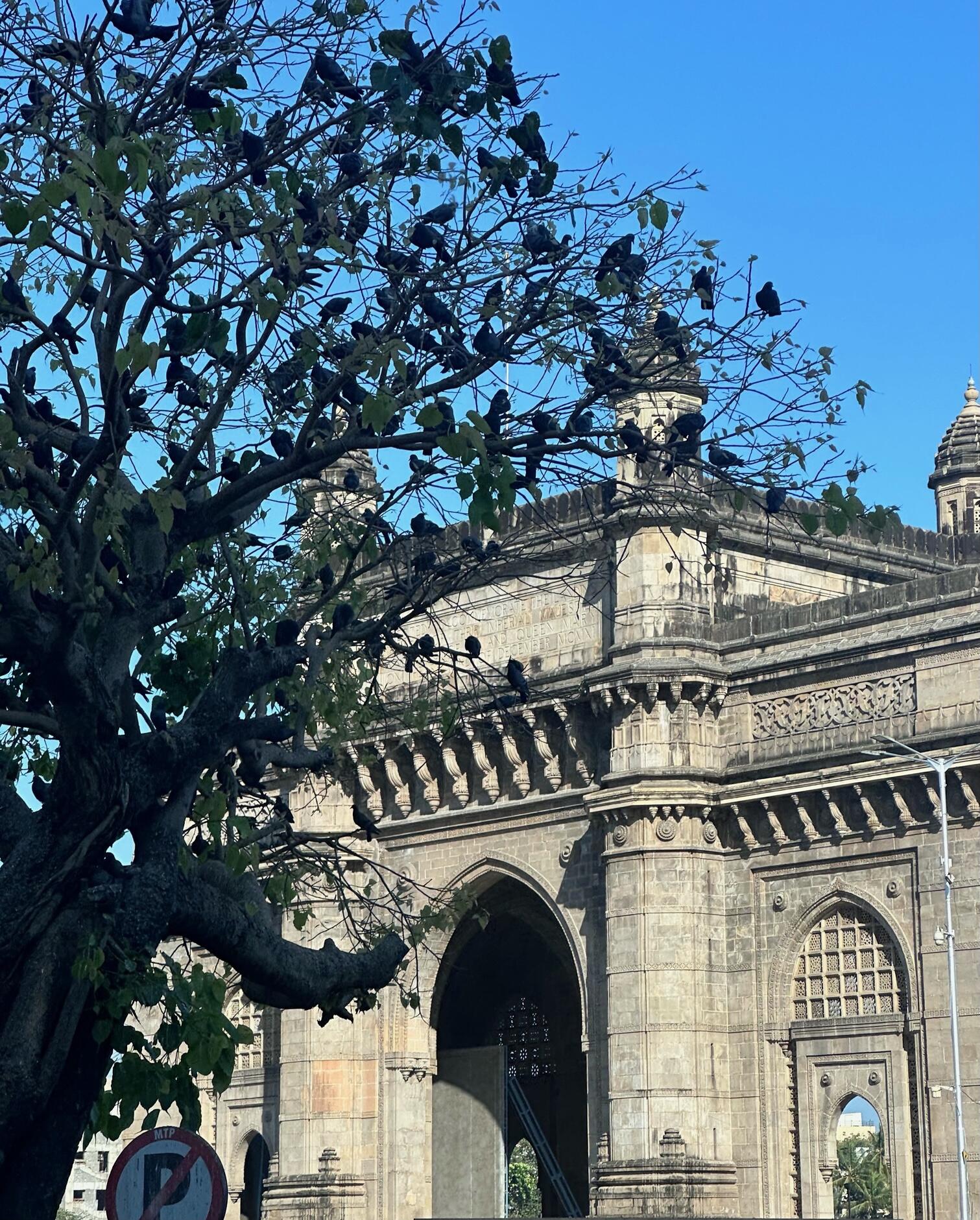
Gateway of India
We passed by several other of the 94 historic buildings in Mumbai including the Reserve Bank of India, the Town Hall built in 1804, Barracks of British soldiers, the Natural History Society, the Police Headquarters, Mumbai University from 1857, and the Indian Naval Headquarters. The navy is very important in India because it is surrounded by water on three sides by the Arabian Sea, the Bay of Bengal, and the Indian Ocean.
The British ruled for almost 250 years. They left behind fabulous structures, a legal system, a form of government, it's language, and infrastructure such as trains and a postal system.
Feeding cows and pigeons satisfies the Hindu custom of doing a good deed every day. Cow feeding stations exist throughout the city.
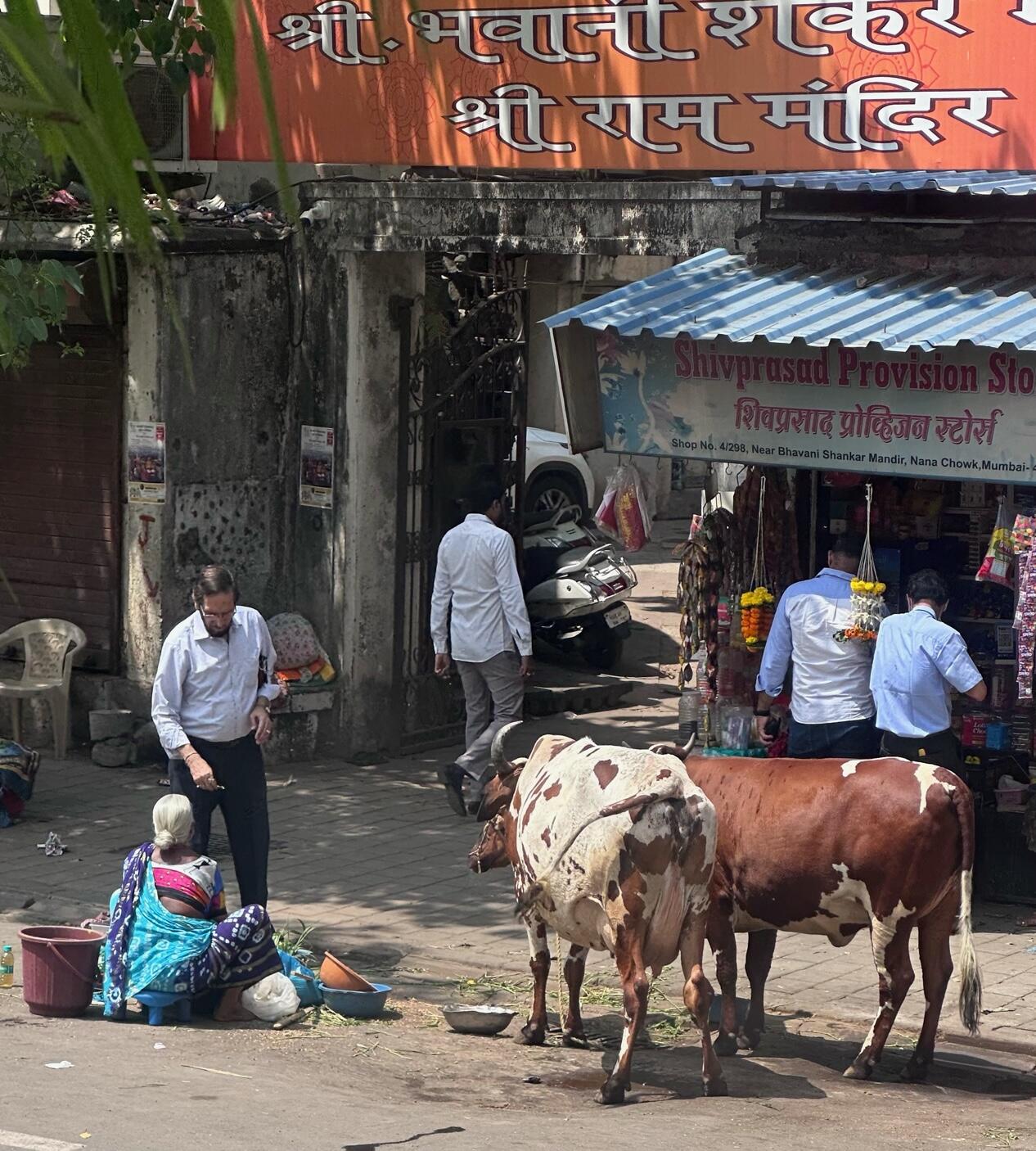
A fleet of 55,000 yellow and black taxis run on compressed gas cylinders that drivers keep in their trunk. In addition, there are 75,000 licensed Uber cabs. It is said there are eight religions in Mumbai. 64 percent of the population is Hindu, 15-18 percent are Muslim and the rest are Jain, Buddhist, Jewish, Parsi, and others. There is a ninth religion worshipped by all - cricket!
The Parsi religion, known outside of Mumbai as Zoroastrian, is fascinating. There are only 110,000 Zoroastrians in the world of which 50,000 live in India. The sect fled from Persia to India between 785 and 936 to avoid religious persecution by the Muslim majority. The Dadar Parsi colony in Mumbai numbers about 15,000 but includes some of India's wealthiest families including the Tatas, who own more than 100 Indian companies. The Parsis worship the elements of nature, not gods. Their places of worship are called Fire Temples where a fire burns 24/7. Only Parsis may enter a fire temple.
Hidden by Mumbai's Hanging Garden, so named because it hangs over a reservoir not because people are lynched there, are 55 acres of land (in the middle of Mumbai!!) owned by the Parsi. On this plot of land are the five Towers of Silence - or dakhma. Parsis do not cremate or bury their dead but place the bodies in these towers to be eaten by vultures. The bones turn into powder. This procedure is only and still performed in Mumbai.
After the Hanging Garden we visited the Mahalakshmi Dhobi Ghat. Dhobi = washerman. It is the largest open air laundry in the world. Over 8000 men work together where each man has his own cubicle, beats the clothes on a rock, air dries, then irons. Home pick up and delivery included. The Dhobi Ghat has been in existence for 120 and started as a service for the British.
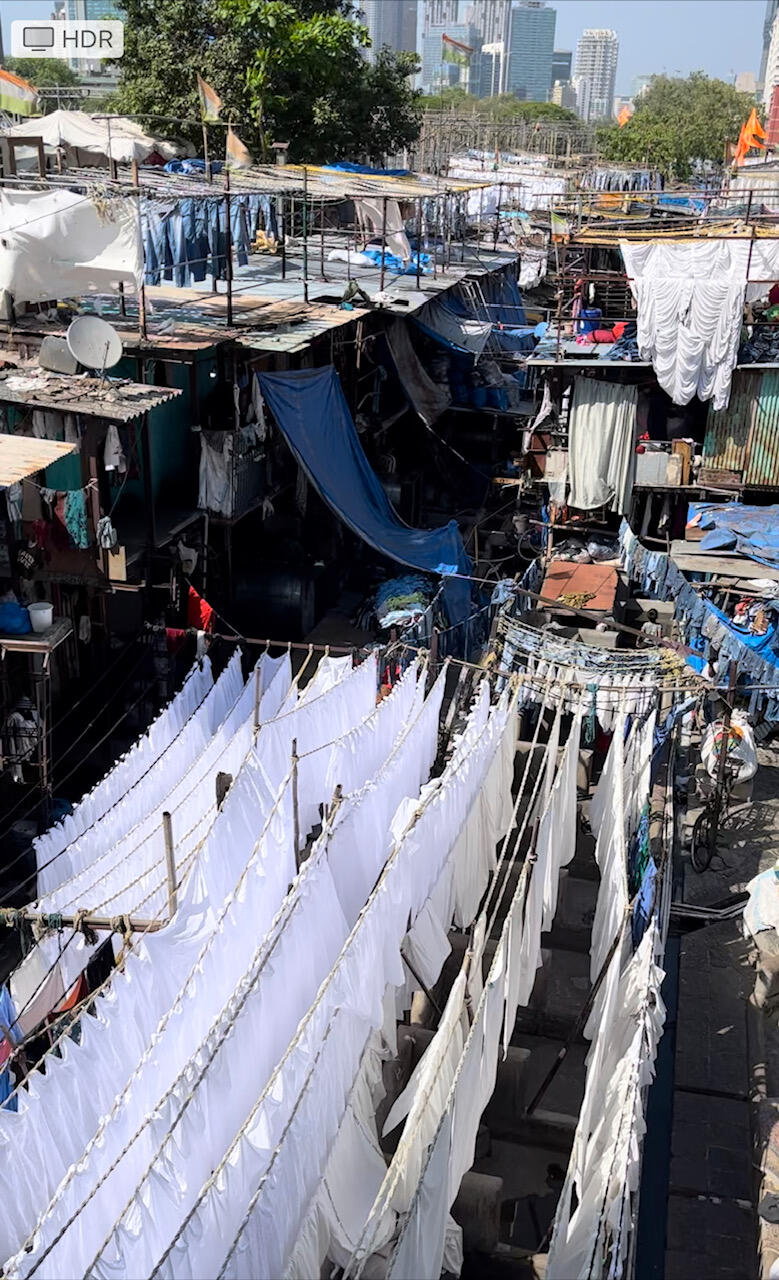
Our last stop today was the former home of Mahatma Gandhi. It is now a museum. It was such a rich and moving experience we will dedicate a post just to that.
Mumbai, Day 2
- At August 27, 2023
- By Jessica
- In Travel
 0
0
Slightly exhausted from last night's reveling we woke up early to attend a Mumbai Mela. A "mela" can best be described as a cross between a folkloric and a bar mitzvah.
It was great fun! Colorful entertainment, turban tying, bangle making, henna painting, and more.
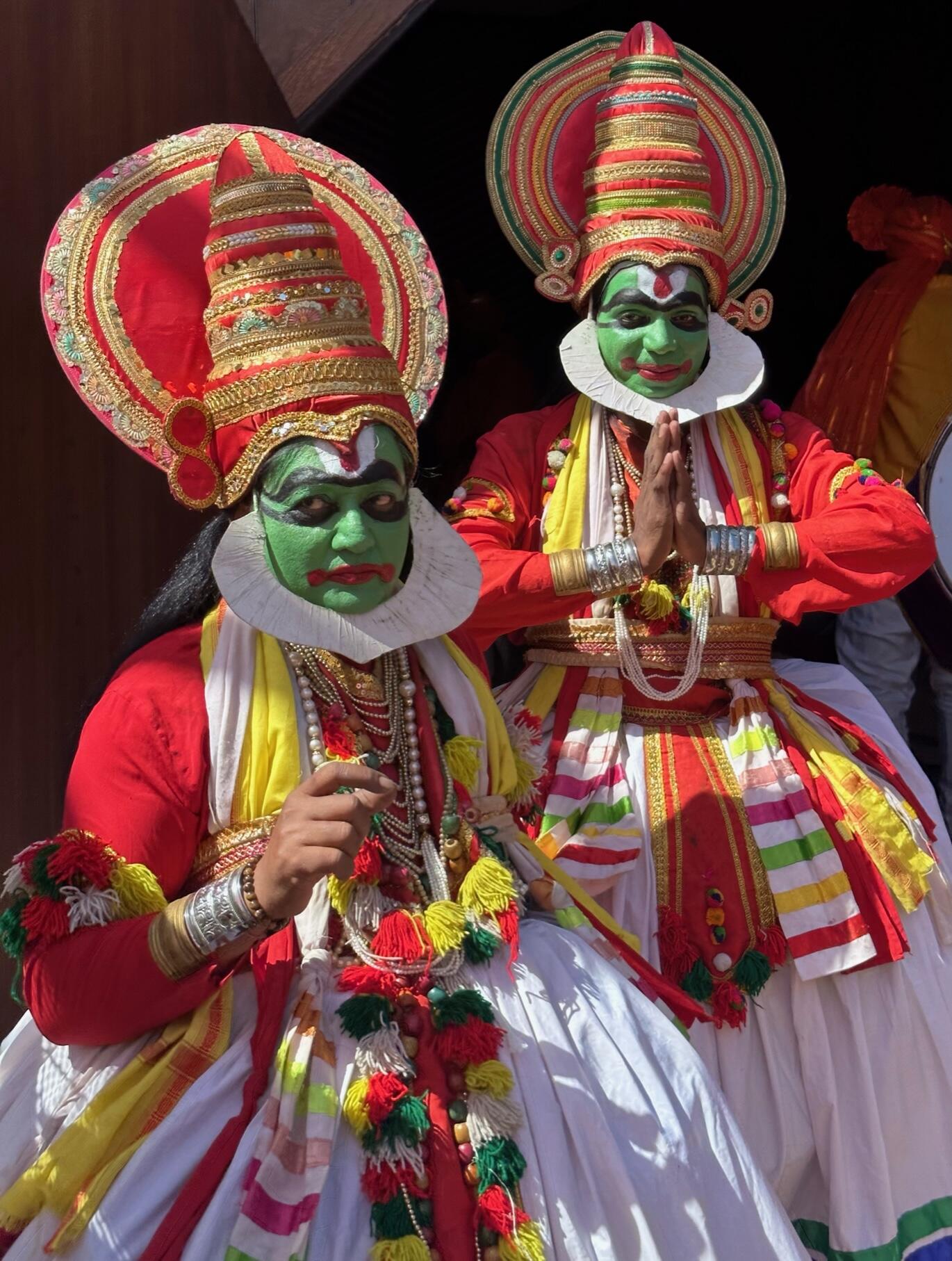
We rushed back to the ship to shower and eat lunch then off to what was billed as a custom tour of private art collections and high tea at the Taj Mahal Hotel.
Upon returning to the pier, we had the following conversation :
Jessica: I wonder what happened to all the dogs we saw last night.
Eberhard: Check your lunch.
Our first stop after lunch (chicken, not dog) was the city's arts district. There are many cultural institutions here, such as the National Gallery, Institute of Science, and Prince of Wales Museum. The architecture is a mix of Victorian Gothic (late 19th c) mixed with Art Deco (early 20th c). The Prince of Wales Museum was built in 1904 for the then POW's 1905 visit. We saw art and artifacts very steeped in Hinduism. No private art collections. Duped again.

Then we headed to the Taj Mahal Hotel for high tea. Taj = crown, Mahal = palace. The story goes that Jamshetji Tata, an Indian salt, cotton, and opium tycoon was turned away by all the elegant hotels in Bombay despite his vast wealth and prominence. During colonial times these hotels posted the following notice: Dogs and Indians not allowed. He decided he would build his own hotel. The Taj, opened in 1903, was the first Indian-owned hotel in Bombay, the first building in Bombay to have electricity, and the first licensed bar in Bombay (the latter not until 1946.)
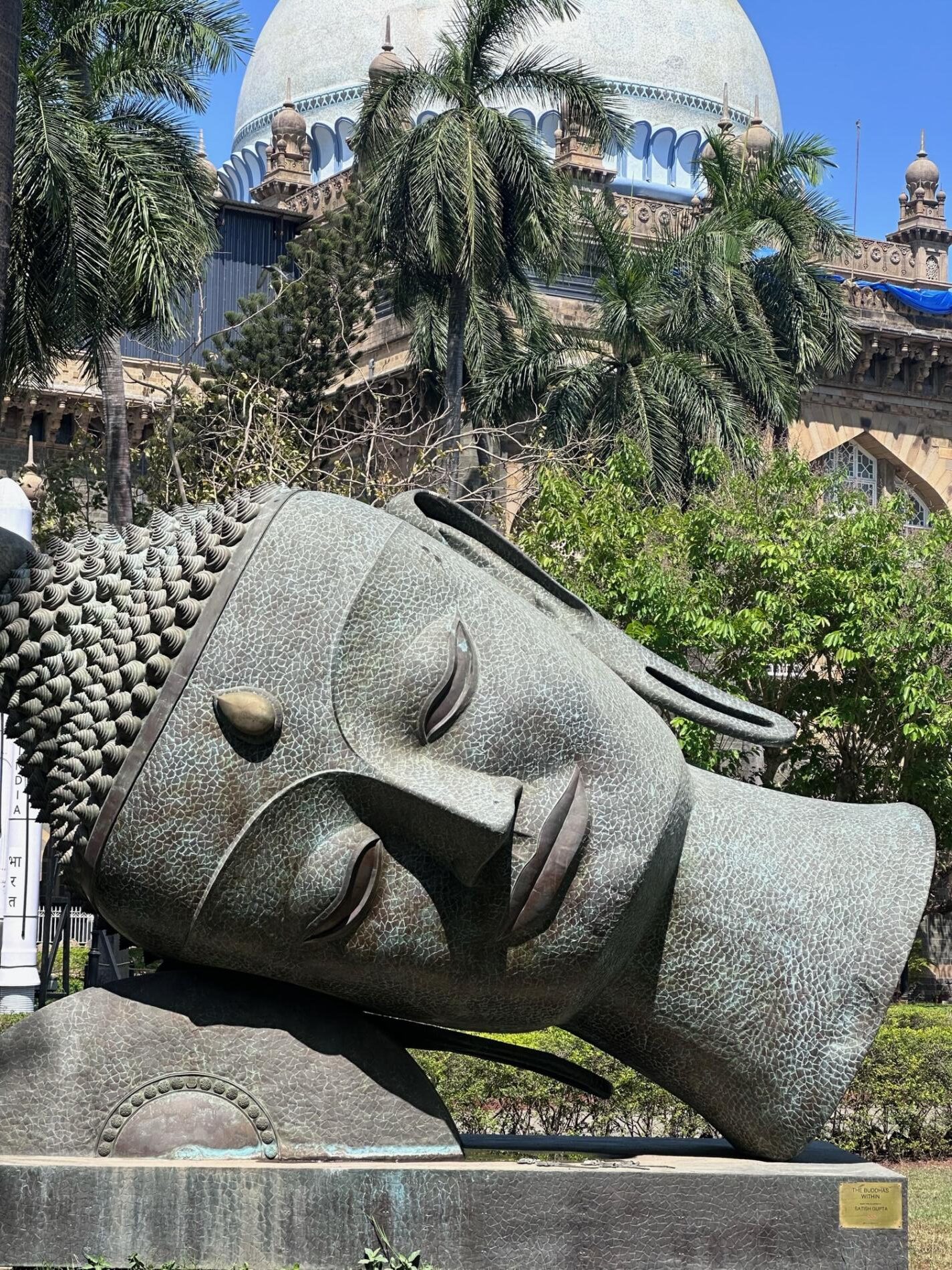
Tata traveled around Europe, cherry-picking the best each country had to offer, such as elevators from Germany. The current management proudly boasted that its German equipment is still functioning. Eberhard could say the same.
Lots of famous people stayed here from Alfred Hitchcock to Barack Obama.
George Harrison got guitar lessons from Ravi Shankar here.
This really is the trip of a lifetime. If our ashes are strewn in the Ganges River think we get to do it again?
Not planning to test that theory any time soon!
Mumbai, Day 1
- At August 20, 2023
- By Jessica
- In Travel
 0
0
Victoria Terminus
We were completely unprepared for how stunning Mumbai is. We've read many books about the slums, political and religious strife, gang rapes, hotel massacres, and vast disparity between rich and poor. All of that exists amidst architecture that is magnificent and grand, thousands of trees, a beautiful beach that runs the length of the city like a sparkling collar. It is extremely painful, however, to see barefoot children and babies living on trash-strewn streets.
An astonishing 62 percent of Mumbai's 22 million population live in slums or on the street. Many others live in dilapidated housing with no gas lines and toilets without water. Yet every other building looks like it's part of Oxford University.
Imagine walking down Fifth Avenue and a cow is blocking rush hour traffic. That's just what happened to us today in Mumbai. Alas.... Bovines, bovines everywhere, but not a steak to eat in this mostly vegetarian culture.
It was a beautiful, breezy, not so humid day in Mumbai or what is still called Bombay by the locals. In 1534, the Portuguese named the city Bom (big) bahai (postal area) - not very glamorous when you dissect it, is it? The city came under the control of the British Crown in 1661 and was immediately leased to The East India Company for 10 pounds per year. The name was changed to Mumbai, as part of the Decolonization Act in 1995. The city's name is derived from Mumbadevi, the patron goddess of the fisherfolk who migrated to the islands from Gujarat centuries ago.
Mumbai is India's wealthiest city, home to Bollywood, and beautiful art deco cinema palaces and hotels reminiscent of Miami Beach. Originally, the city was seven islands inhabited mostly by fisherman and salt merchants. Fortification and land reclamation efforts undertaken by the British made one land mass. This project was completed in 1918, which explains the preponderance of art deco buildings along the shore.
Victoria Terminus Train Station is a magnificent building melding multiple architectural styles. It is beautifully lit up at night, apparently electrified for the G20 meeting.
Trains are the city's lifeline, where 8 million people commute daily. Local trains leave every three minutes and have NO AC. Each train has twelve coaches of which three are exclusively for women. During the lengthy security procedures every time we get on or off the boat, men and woman must be separated.
It is fascinating to us how common it is to have many generations of family living together under the same roof of a rambling old apartment. Our dinner hosts have a 50 year old son, his wife and child, and their 45 year old unmarried son all living with them. She says, "It's a party all the time." We just read a book called Family Matters by Rohinton Mistry (yes the same author as A Fine Balance) on this subject. It was terrific.
Mumbai is known for its diversity of neighborhoods so we embarked on a walking tour to get a first hand feel. One area looks like Embassy Row in Washington, DC, lined as it is by former English private clubs. We were invited by friends to fine at their club last night. The club is still named after British Lord Willington.
The Malabar Hill neighborhood faces the Arabian Sea. One of Jessica's book groups read The Widows of Malabar Hill a couple of years ago. Another interesting read.
According to Hindu religion, ashes of dead persons must run through the waters of the sacred River Ganges in order to return to the cycle of life to be reborn. The Ganges does not run through Mumbai but human beings are nothing if not resourceful so we visited this lake fed by a fresh water spring reputed to originate at the Ganges.
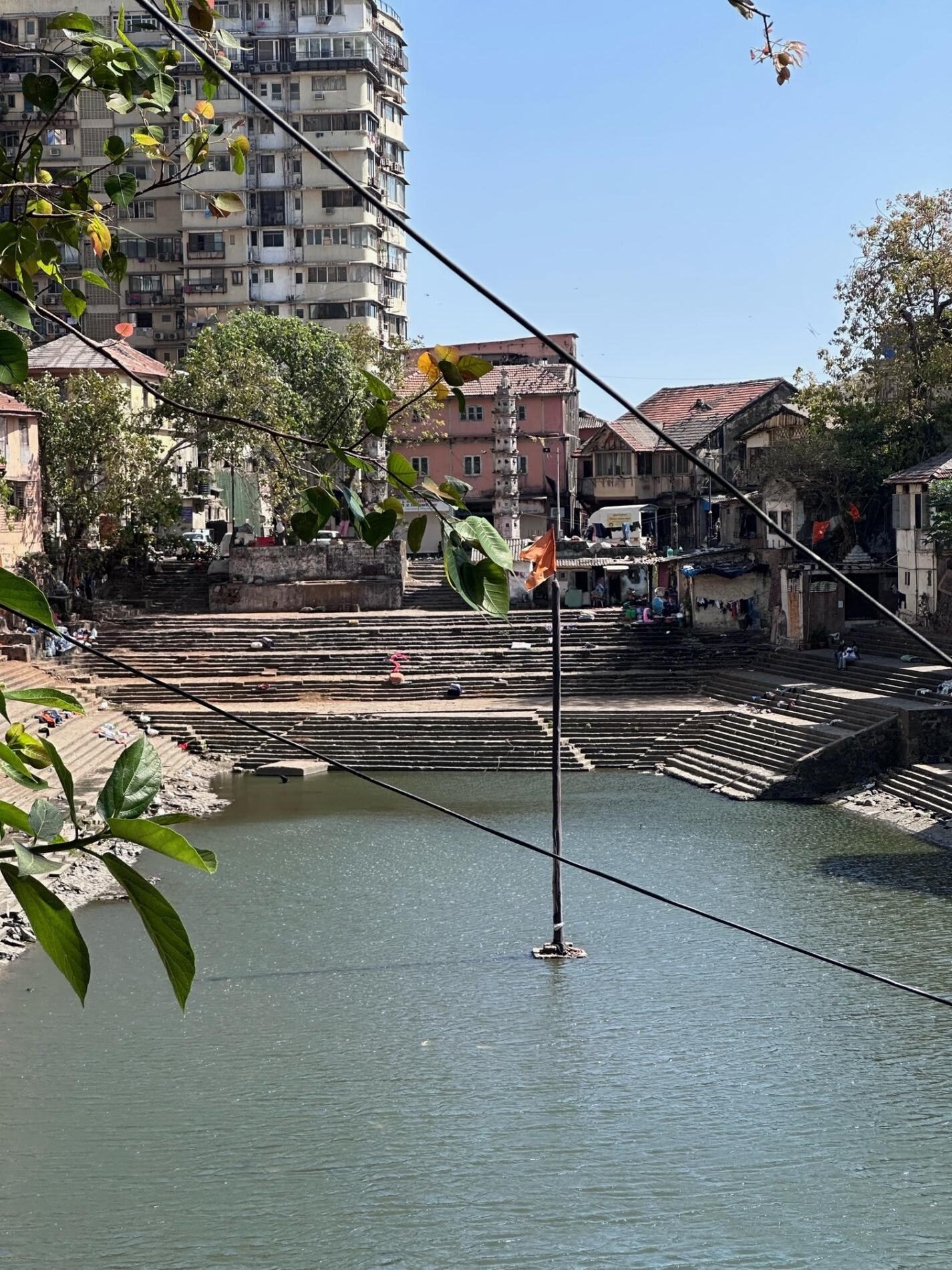
Before 10 am every morning Mumbai residents can be found performing these death rituals. First they immerse the ashes of the deceased, then they shave their heads, (there is an enterprising barber at the lake,) then they bathe, then they go to temple but only after ten days of mourning.
After our fascinating walking tour of Old Mumbai, we proceeded to a fashion designer's home/showroom. The charming Portuguese style home has been in the designer's family for 220 years. Jessica made a new friend in the dressing room - Sangeeta. We will meet her again. Needless to say, we made a huge contribution to the Indian economy before leaving the shop.
Certainly the highlight of the day was a wonderful dinner with our friends mentioned earlier. Their club is gorgeous, like stepping back in time to the Raj era. And we let them order for us so we sampled a smorgasbord of Indian delicacies. We wonder how you say smorgasbord in Hindi?
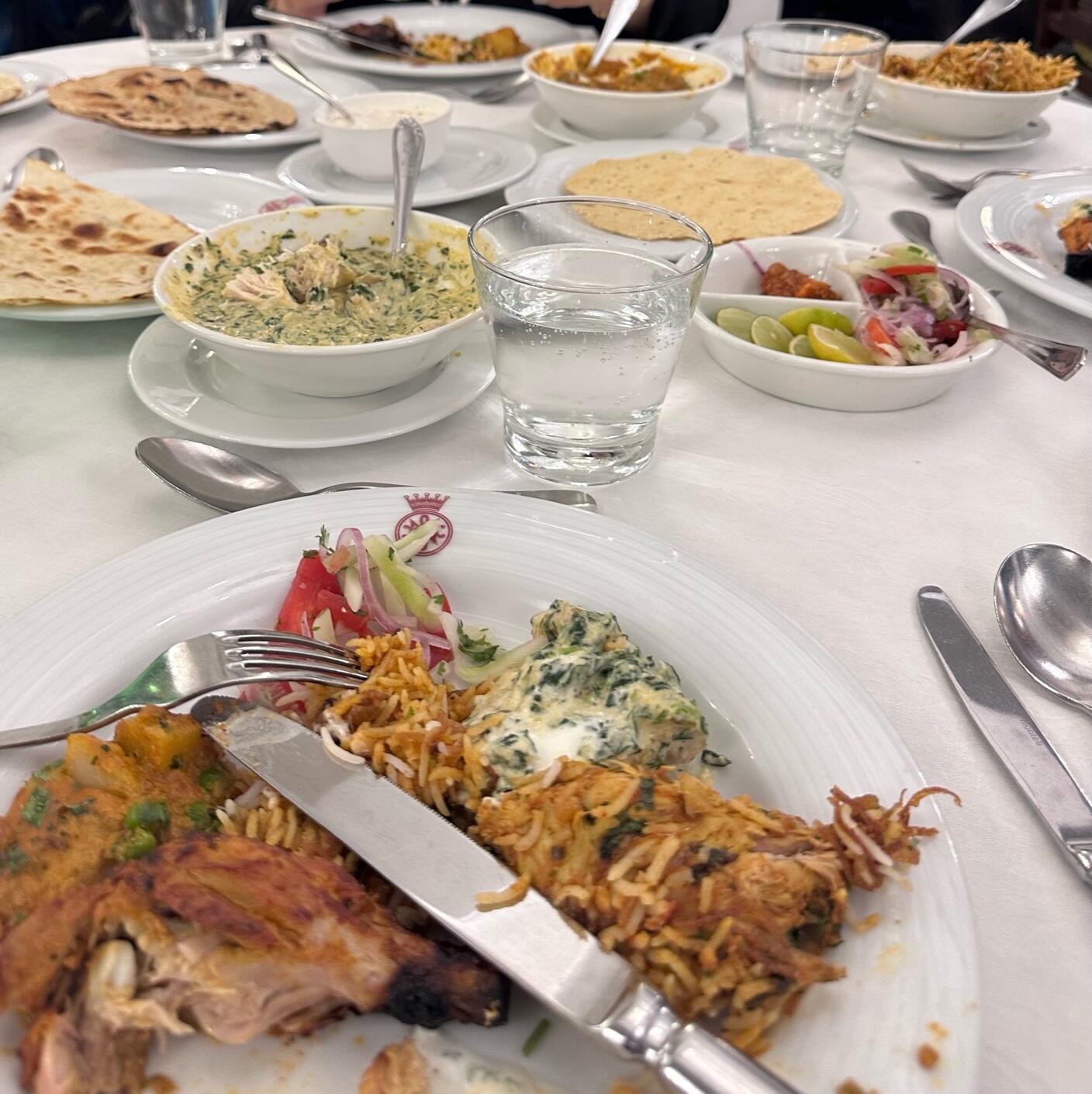
It was a little creepy coming back late at night. The port is abandoned save for starving packs of stray dogs (and we don't just mean the cab drivers). Next time we travel abroad we're going to pack a suitcase full of dog biscuits.

